|
Me Sahyadri |
|
February 2018 |
|
Volume 5, number 4, # 58 |
|
Mysteries of Maval Caves – Pillars of Karle Chaityagriha |
Please use minimum 1280 pixel horizontal screen resolution for viewing. Please be patient while all the images in webpage are loaded. Please do not use the images for any commercial use without permission. Text in Marathi and English is not exact translation. Please give sufficient time to allow the photographs to load. Special thanks to those who helped me during the compilation and for the help and guidance during the activity. |
|
|
|
|
देशाची आर्थिक प्रगती व्हावी असे सर्व नागरिकांना वाटणे सहाजिक आहे. अर्थकारणामुळे मिळणारा रोजगार, समृद्धी यासाठी सर्वांनाच आर्थिक प्रगती हवी हवीशी वाटते. आर्थिक प्रगती होताना, त्याचा दिर्घकाळात समाजावर, निसर्गावर, वातावरणावर दुष्परिणाम होणार नाही याची काळजी घेणे महत्वाचे आहे. मनुष्याच्या भावी पिढ्यांना पाणी, शुद्ध हवा, योग्य वातावरण मिळत रहावे अशी भावना मनात रुजणे महत्वाचे आहे. वाढत्या आर्थिक प्रगतीमुळे नैसर्गिक संपदेवर ताण येतो. प्रगतीसाठी प्रदुषण होते. जंगले, माळराने, व इतर अधिवास नष्ट होतात. वसुंधरेवर रहाणाऱ्या इतर जीवांचा मात्र मनुष्य फारसा विचार करत नाही. आर्थिक प्रगती करताना, मनुष्य निसर्गाची हानी करत आहे. मुळताच माणसाला निसर्गाचे महत्व समजणे हे सध्याच्या आपल्या प्रगत जीवनशैली मुळे अवघड झाले आहे. आर्थिक प्रगती, समाजाची प्रगती व निसर्ग संपदेची निगा, यांचा समतोल राखणे काळाची गरज आहे.
सह्याद्री (पश्चिम घाट) हा एक नैसर्गिक संपदेचा, वैविध्यतेचा, भौगोलिक व ऐतिहासिक ठेवा आहे. वाढत्या मानवी अतिक्रमणाचा, सह्याद्रीच्या विविध घटकांवर होणारा दुष्परिणाम भविष्यात आपल्यालाच धोका निर्माण करेल, यात शंका नाही. शुद्ध पाणी, हवा व उर्जा, भावी पिढीला मिळण्यासाठी, नंद्यांचे उगम असलेला सह्याद्री व त्याभागातील जंगले टिकवणे महत्वाचे आहे. सह्याद्रीच्या महत्वाच्या घटकांचे महत्व छायाचित्रांद्वारे प्रकट करण्याचा मी येथे प्रयत्न केला आहे. येथील पक्षी, प्राणी, वनस्पती, अधिवास, किल्ले व लेणी अशा विविध विषयांबद्दल आपण समजुन घेऊ.
|
|
As the economic development has taken the center stage, the balance between the environmental sustenance and socio economic development will be under the scanner. As most experts with balanced views have proclaimed, Indian wildlife and ecological system sustenance will be under threat, unless precautions are taken with the help of appropriate research and long term national interests. As we encounter the economic development, many habitats which indirectly or directly help sustainable development will be damaged. The awareness to gauge the success by sustainable development and not by year to year growth is a distant dream any environmentalist will assume in current scenario.
Western ghats, or Sahyadri as we all call it as, is a treasure trove of spectacular landscapes, biodiversity, flora, fauna, some amazing geological wonders and man made monuments. With the increasing pressure from human encroachment, all these elements are under stress and in turn are under depletion. Western ghats should be left untouched by human beings, to protect their future generations from getting short of resources, such as water, energy and clean air. The important elements of western ghats, which need protection are highlighted in the new version of Photo journal, Me Sahyadri Magazine.
|
|
|
| |
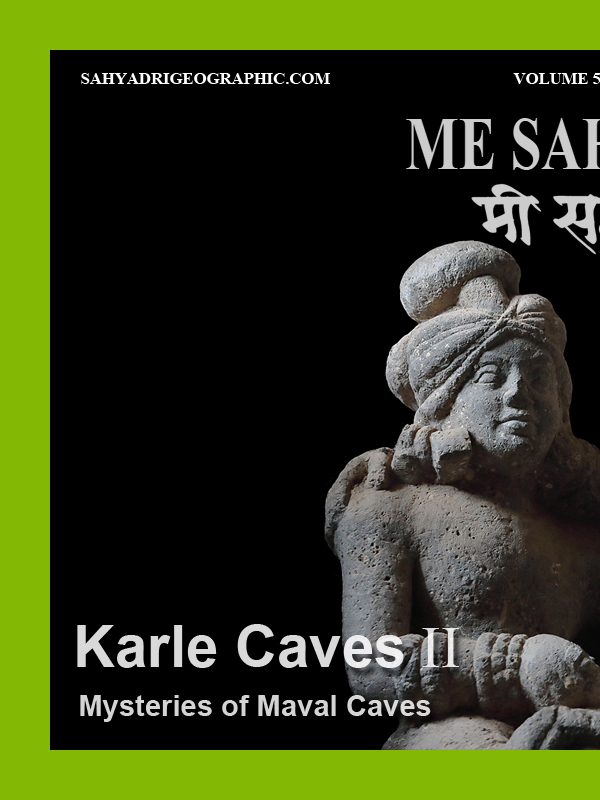 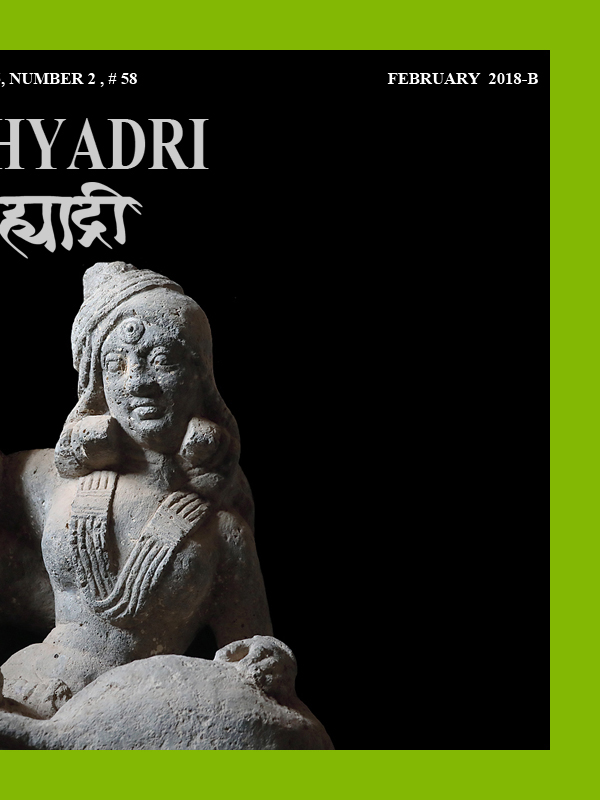
|
| |
| Me Sahyadri – February 2018 - B
|
| |
|
|
मावळ लेणी मोहेमेचा सारांश :
मावळातल्या लहान लेण्यांचा शोध घेण्यात जेवढे कष्ट पडले, तेवढेच कष्ट बेडसे, कार्ले, आणि भाजे च्या लेण्यांतील बारकावे समजवुन घेताना पडले. या लेखात कार्ले लेण्यातील काही सुंदर बारकाव्यांचा पसारा मी इथे मांडला आहे.
मावळातील भाजे, बेडसे आणि कार्ले लेणी अप्रतिम आहेत. त्यामुळे या भागातील इतर लहान लेण्यांकडे फारसे कोणी फिरकत नाही. आम्ही चार समविचारी मित्रांनी मात्र या हरवलेल्या लेण्यांची शोधाशोध करण्याचे ठरवले. साईप्रकाश बेलसरे, निनाद बारटक्के, अमेय जोशी आणि विवेक काळे असा संघ तयार झाला. एकोणीसाव्या शतकात जेम्स बर्जेस आणि जेम्स फर्ग्युसन या दोन इंग्रज विद्वानांनी भारतातील लेणी धुंडाळली. त्यांनी १८८० साली "केव्ह टेम्पल्स ऑफ इंडिया" या पुस्तकाचे प्रकाशन केले. या पुस्तकात मावळातील लहान लेण्यांचा फारसा तपशिल नसला तरी, या मावळातील इतर लहान लेण्यांबद्दल ५-६ वाक्यांमध्ये आम्हाला त्रोटक का होईना माहिती मिळाली. त्यांनी उल्लेख केलेली, काही ठिकाण सापडली, तर काही ठिकाण काहीही केल्या सापडेनात. कदाचित न सापडलेली ठिकाण नष्ट झाली असावीत. पण मोहिमे दरम्यान नविन, ज्या ठिकाणांचा पुस्तकात उल्लेख नव्हता, पण ग्रामीण भागातल्या स्थानिकांना माहिती होती अशी ठिकाण सापडली.
जेम्स बर्जेस आणि जेम्स फर्ग्युसन या दोन इंग्रज विद्वानांनी लिहिलेल्या प्रत्येक शब्दाचा धागा म्हणुन वापर करायचे ठरले. कामांचे वाटप झाले.
शोध मोहिमेत लागणाऱ्या खाऊची सोय करणे, विषय आणि ठिकाणाचा आधी अभ्यास करणे, प्रवासाची सोय करणे, गावकऱ्यांकडे लेण्यांबद्दल चौकश्या करणे, मोहिमे दरम्यान गचपणातुन वाट शोधणे, लेण्याच्या अवशेषांची मोजमाप घेऊन त्याची चित्रे/नकाशे काढणे, छायाचित्रे काढणे, जि. पि. एस. यंत्रावर वाटेबद्दल माहिती नोंदवणे, लेण्यात लहान बारकावे शोधणे, लेण्यांचे विश्लेषण करणे, नोंदी करणे, अशी वेगवेगळ्या प्रकारची काम वाटुन घेण्यात आली.
प्रत्येक ठिकाणी जाताना, घरचा अभ्यास करावा लागला. जुनी पुस्तके, नकाशे धुंडाळले गेले. गावातल्या मित्रांची मदत झाली. गावागावात चौकश्या केल्या. गडद, लेणे, गुहा, कपार, भोगदा, विहार, पांडवांनी एका रात्री बनवलेली गुहा असे अनेक शब्द वापरुन चौकश्या झाल्या. बहुतेक वेळा असे काही नाही इथे ! तुम्ही कुठुन आलात ? असे उत्तर मिळाले. लेणे आहे का इथे कुठे असा प्रश्न विचारला तर आम्हाला बहुतेकांनी कार्ले/बेडसे/भाजे लेण्यांचा पत्ता दिला. पण बकऱ्या, गाई घेऊन डोंगरात फिरणारे गुराखी मात्र दरवेळेला मदतीला धाउन आले. वाटांचे आणि दिशांचे अंदाज मिळाले. जुजबी माहिती घेऊन ठिकाण शोधणे या प्रकाराचा चांगला सराव झाला. कधी काटेरी करवंदींच्या खालुन खुप सरपटाव लागल तर कधी घसाऱ्यावर हात टेकावे लागले.
लेण्यांमध्ये मोठे कोळी (स्पायडर), कातळ पाली, वटवाघळ, मधमाश्या, पाकोळ्या, घुबडं भेटले. आमच्या मुळे त्यांना उगाच त्रास झाला, असा अपराधीपणा वाटला. प्रत्येक शोधमोहिमेला यश आलेच असे नाही. काही ठिकाण सापडली नाहीत. तर काही ठिकाण आमच्याच मनाचे खेळ आहेत असे लक्षात आले. बहुतांश ठिकाणी कोणत्या ना कोणत्या प्रकारची जोखिम होती. वटवाघळ, लेण्यातील धुळ, काळोख, मधमाश्या, काटेरी वनस्पती, घसारा, गुहेतील ऑक्सिजन चा अभावआणि इतर न दिसणारे धोके यावर मात झाली. मोहिमेसाठी, विजेऱ्या, जि. पि. एस., मोजपट्या, दोऱ्या, लेजर यंत्र, नकाशे, गुगल मॅप, जाळीच्या टोप्या या सर्व जंत्रीचा उपयोग झाला. एकूण मिळुन २० नविन अपरिचित ठिकाण/वास्तु पहायला मिळाल्या, मावळाचा भुगोल जरा अजुन नीट लक्षात आला. नविन प्रश्न पडले आणि नविन कोडी सोडवयाला मिळाली. तर्क वितर्क झाले.
|
|
About the Maval Cave exploration :
The main caves in Maval region are so significant, but often overlooked by the visitors when it comes to the details. In this photo-essay I have tried to bring few details at Karle caves to surface.
The main caves in Maval region are so significant that other small hermit caves are often overlooked. We as a team of four like minded friends, decided to explore the Maval region for these small hermit caves. We explored and found few beautiful places. The very concept of creating a hermit cave somewhere high up in the hills is fascinating. These places often are full of tranquility and nothing else. With very little architectural evidences and clues, the academicians have obviously ignored these places. It was James Fergusson and James Burgess, during their exhaustive study of “Cave temples of India, 1880” mentioned few of these hermits in Maval region of Pune district. With the little clues and exhaustive investigation, team of four members, Saprakash Belsare, Amey Joshi, Ninad Bartakke and Vivek Kale started the exploration. The journey to locate, trek and analyse these hermit caves itself was fascinating. We met many villagers who were unaware of these places, but also met few shepherds who were precisely aware of the hermits and gave us tentative guidance.
There is a very brief mention about the miscellaneous caves of Maval by James Fergusson and James Burgess in their work. Based on available information we decided to search these caves and monuments. The activities were planned. The food, travel , track exploration in difficult and routes full of foliage, enquiring the villagers about the caves, taking measurements and drawing sketches and maps, photography, GPS data collection, making notes and analysing the information, observing the minor details of the caves etc activites were distributed amongst the team members. We met many bats, owls, geckos, lizards, large spiders, martins, honeybees during the treks. Often we felt sad that we disturbed them to see the caves. Most of these places are hazardous due to pitch darkness, bats, dust, thorny plants, honeybees, low oxygen level in caves and rock patches etc. Not all the attempts were successful. Sometimes we could not find the intended places and sometimes we realised that the cave was just our imagination and did not exist. Nevertheless, we saw about 20 new strange caves/monuments during the exploration. The high intensity torches, GPS tool, measuring tapes and measuring laser tool, Honeybee protection caps, maps, google maps, photographs etc. were useful during the mission.
|
|
|
| |
  |
| The banner has been published here to improve the awareness of the trekkers and tourists visiting the various mountain forts, mountains in north western ghats. Please avoid accidents, by following good outdoor ethics such as no swimming in cisterns at mountain forts, no rock climbing without proper technical equipment and expertise. Please do not adventure, trek with any group or individually without understanding the risks associated. The frequency of the solo trekker fatalities have increased recently. Please strictly avoid solo treks. Please also avoid treks to mountains in large commercial groups, as it leads to damage to biodiversity of these high elevation ecological islands. Please respect the wildlife and biodiversity of the region. This has become more important as the ever increasing human interference is leading to severe damage to fragile ecosystems. Please be aware of the wildlife and biodiversity of the mountains before visiting these mountains. Please follow outdoor ethics. Follow ASI and Forest department rules. The concept of use of symbols for outdoor ethics was conceived and designed by "Sahyadri Trekker Bloggers Group". |
| |
|
|
| |
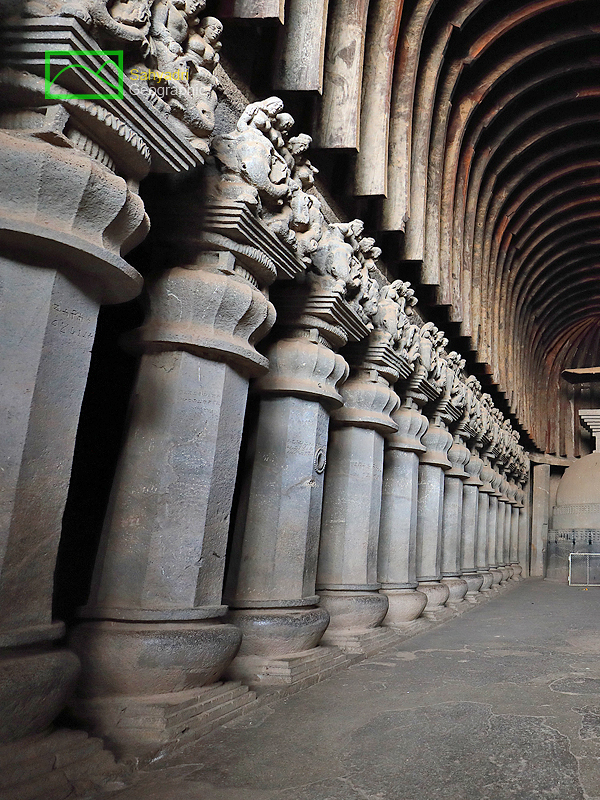 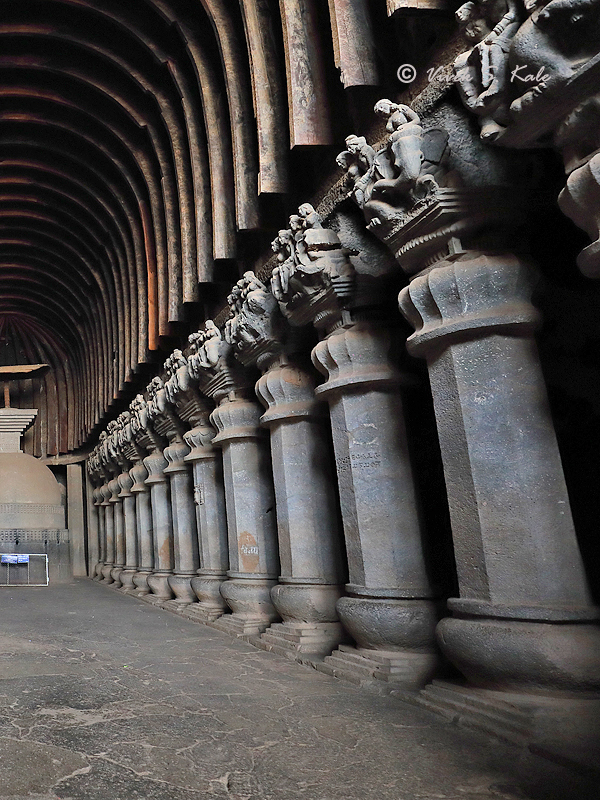 |
| |
| 1. Chaityagriha, Karle Caves, Maval Tehsil, Pune district, Maharashtra, India |
| |
|
|
कार्ले येथील चैत्यगृह भारतातील सर्वात भव्य व अप्रतिम चैत्यगृह आहे. चैत्यगृहाची लांबी दरवाजापासुन मागच्या भिंतीपर्यंत ३७.८ मीटर आहे. चैत्यगृहाची रुंदी १३.८ मीटर आहे. चैत्यगृहाची उंची १४ मीटर आहे. छत अर्धवर्तुळाकार आकाराचे आहे. चैत्यगृह खांबांमुळे दोन भागात विभागलेले आहे. खांबांच्या मागचा भाग आणि खांबांसमोरचा मुख्य भाग असे दोन भाग आहेत. डावीकडची आणि उजवीकडची खांबाची रांग स्तुपाच्या मागे अर्धवर्तुळात एकमेकांना मिळते.
चैत्यगृहातले कोरलेले खांब अप्रतिम आहेत. खांबाच्या सर्वात खाली तीन चौकटी आहेत. चौकटींवर खांबांना अर्ध गोल माठासारखा आकार दिला आहे. त्याच्यावरचा खांब अष्ट्कोनी आहे. वरच्या भागात पाकळ्या असलेल्या कमळाचा आकार आहे. त्यावर असलेल्या चौकटींवर हत्ती, घोडे व इतर प्राण्यांवर आरुढ मानवी शिल्पे आहेत. खांबांच्या वर पुढे व मागे दोन्ही बाजुस मानवी शिल्पे आहेत. पुढच्या भागात हत्तीवर आरुढ शिल्पे आहेत, मागच्या बाजुस मानवी शिल्पे हत्ती, घोडे, आणि सेंटॉर/स्फिंक्स वर आरुढ आहेत. एकुण मिळुन ४१ खांब आहेत. दरवाज्याच्या जवळचे सज्जाच्या खालचे चार खांब अष्ट्कोनी नाहीत. इतर सर्व खांब अष्टकोनी आहेत. स्तुपाच्या जवळच्या सात अष्टकोनी खांबांवर शिल्पे नाहीत.
|
|
The chaityagriha at Karle is the biggest of its type in the whole of India. The hall measures 37.87 m deep from door to back. It is 13.87 m wide and 14.02 m high. This chaitya consists of an apsidal hall with a front verandah. The apsidal means the semicircular recess roof. The hall is divided into a nave (central open space) and two aisles (passages) by two rows of pillars. The two rows of pillars meet at the rear behind the stupa in a semicircle forming the semicircular recess.
The pillars are executed with the great ingenuity which reflect the sculptural art of the period. The pillars consist of a stepped base surmounted by a pot, octagonal shaft over it, the capital of inverted flower vase member, caged amalaka and an inverted stepped pyramid. Above this inverted stepped pyramid there are sculptures of animals with human riders, facing both aisle and main hall. The animals on the capital consist of elephants, horses and centaurs/sphinx like mythological animals. Centaurs are greek mythological animals with human face on horse body. There are total 41 pillars in Chaitya griha. The four pillars parallel to front wall near the entrance are non octagonal and support the beam. There are seven pillars around Stupa which are octagonal but without sculptures atop.
|
|
|
| |
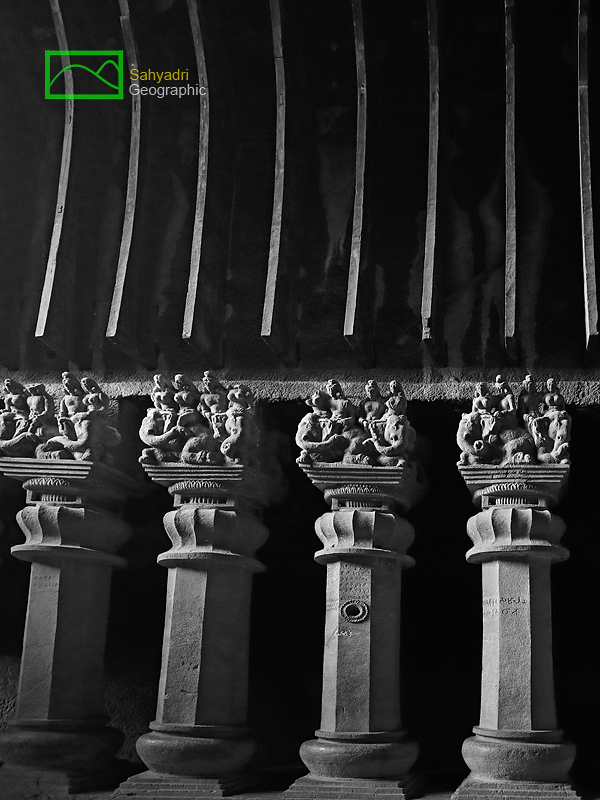 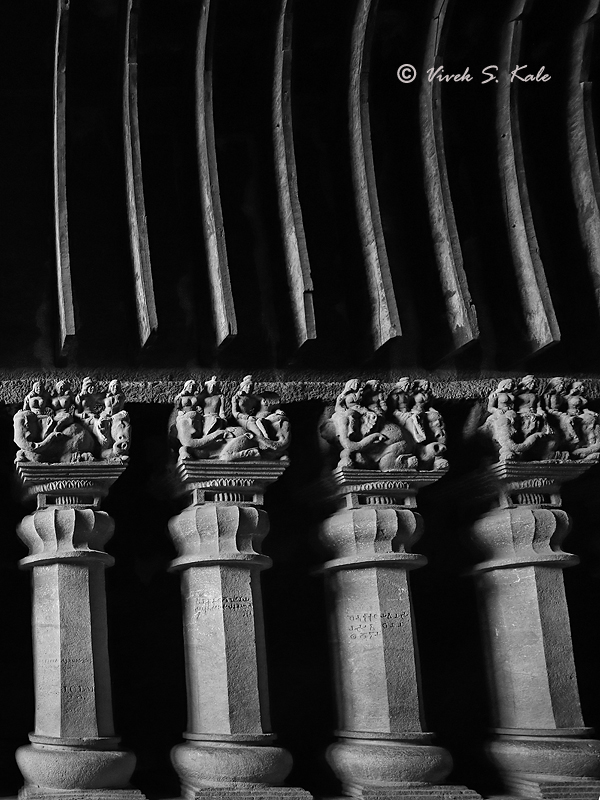 |
| |
| 2. Pillars at Chaityagriha, Karle Caves, Maval Tehsil, Pune district, Maharashtra, India |
| |
|
|
| |
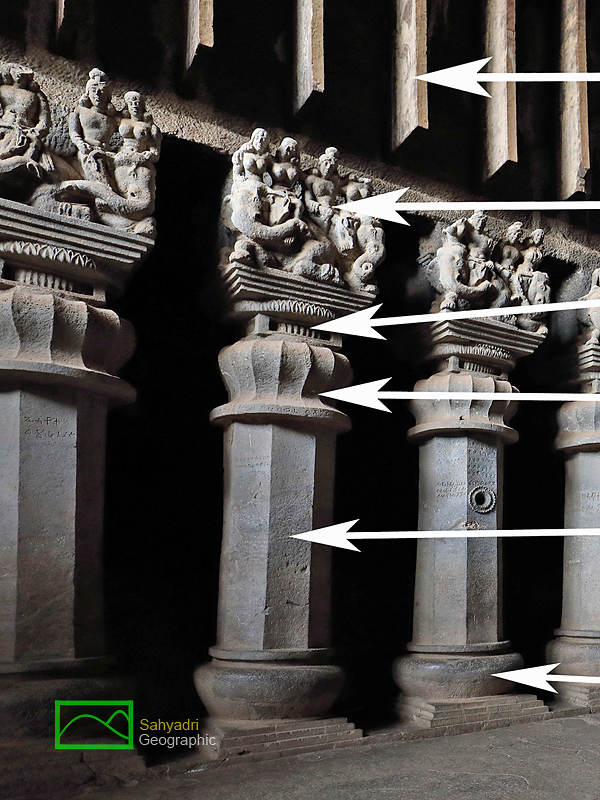 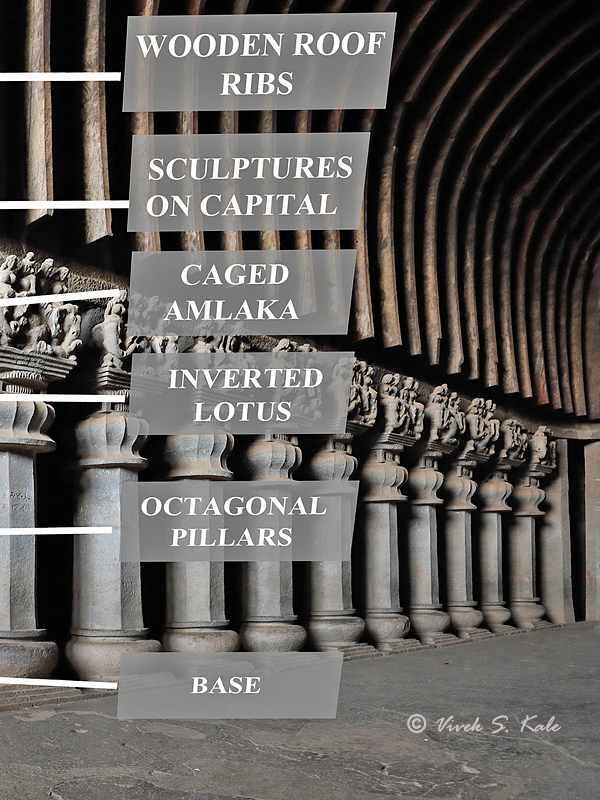 |
| |
| 3. Pillars at Chaityagriha, Karle Caves, Maval Tehsil, Pune district, Maharashtra, India |
| |
|
|
| |
 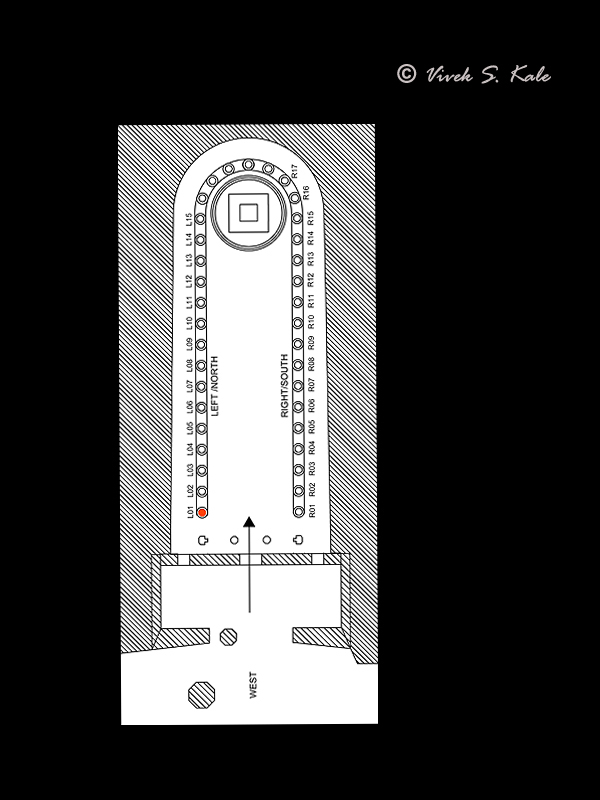 |
| |
| 4. Pillar L1, Chaityagriha, Karle Caves, Maval Tehsil, Pune district, Maharashtra, India |
| |
|
|
छायाचित्रात पहिला अष्टकोनी खांब (डाव्या रांगेतील/ उत्तरेकडील) दाखविलेला आहे. यात खांबावरची पुढच्या बाजुची शिल्पे दाखविलेली आहेत. या शिल्पात दोन हत्ती आहेत. दोन्ही हत्तींवर स्त्री-पुरुष जोड़्या आरुढ झालेल्या आहेत. स्त्री शिल्पात कंबरपट्टा, बांगड़्या, कपाळावरचे आभूषण (टिका) ही आभूषण आहेत. या खांबावर इतर खांबांपेक्षा वेगळे कोरिव काम आहे. यावर लहान वाळूच्या घड़्याळाची चिन्हे कोरलेली आहेत. या खांबाच्या वरच्या घड़्यावर पाकळया कोरलेल्या आहेत. या खांबाच्या मागच्या बाजूस स्त्री-पुरुष जोड़्या बैल आणि घोड़्यावर आरुढ झालेले पहावयास मिळतात. वाळूच्या घड्याळाचे चिन्ह एक महत्वाचे चिन्ह आहे. वर्तमान काळ, भूतकाळ आणि भविष्यकाळ यांच्या मध्ये आहे असे हे वाळूचे घड्याळ चिन्ह दर्शविते. माणसाचे अस्तित्व तात्पुरते असून वाळूच्या घड्याळातल्या वाळूप्रमाणे वेळ निघून जाते.
|
|
First octagonal pillar, (with sculptures on its capital) on left hand side (person facing stupa) i.e. on north side in Karle Chaityagriha is shown in the image. In this image, only the sculptures facing the main hall are highlighted and the image does not show the other details such as top of the pillar, backside of the pillar and wall behind. On both the elephants, human pair of male and female are riding. Interesting ornaments such as waist jewelry, wrist bracelets and forehead jewelry can be seen here on the female riders. The wrist bracelet can be seen on the male rider. Both female rider have intricate large sized necklace. This pillar has some additional ornamentation as compared to other pillars in Chaityagriha. The upper disc of the pillar above the octagonal section is carved with small hourglass symbols. There is also a petal type design on the pot type section above the disc. This pillar has male and female human riders riding on bull and horse on the alley side (back side).
The hourglass represents the present as being between the past and the future and this has made it an enduring symbol of time. The hourglass is depicted as a symbol that human existence is temparary, and that like sand the time runs out in every human life
|
|
|
| |
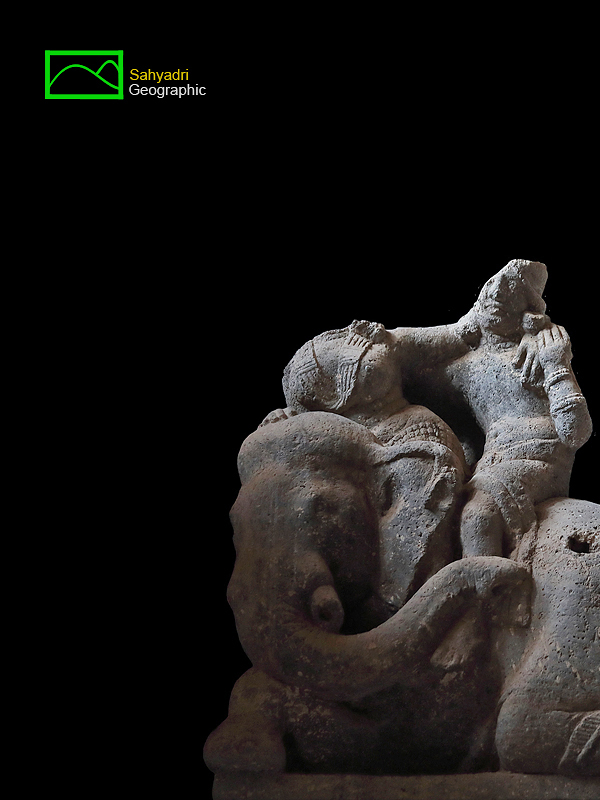 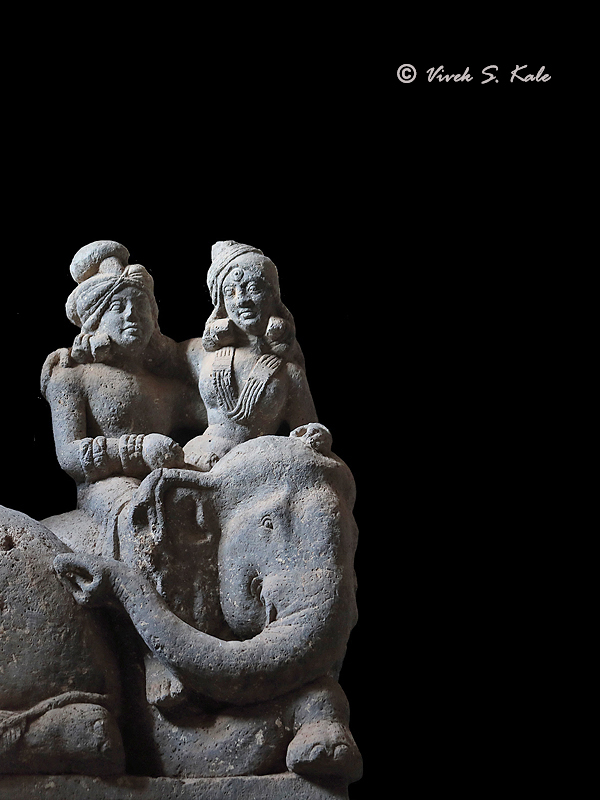 |
| |
| 5. Pillar L1, Chaityagriha, Karle Caves, Maval Tehsil, Pune district, Maharashtra, India |
| |
|
|
| |
 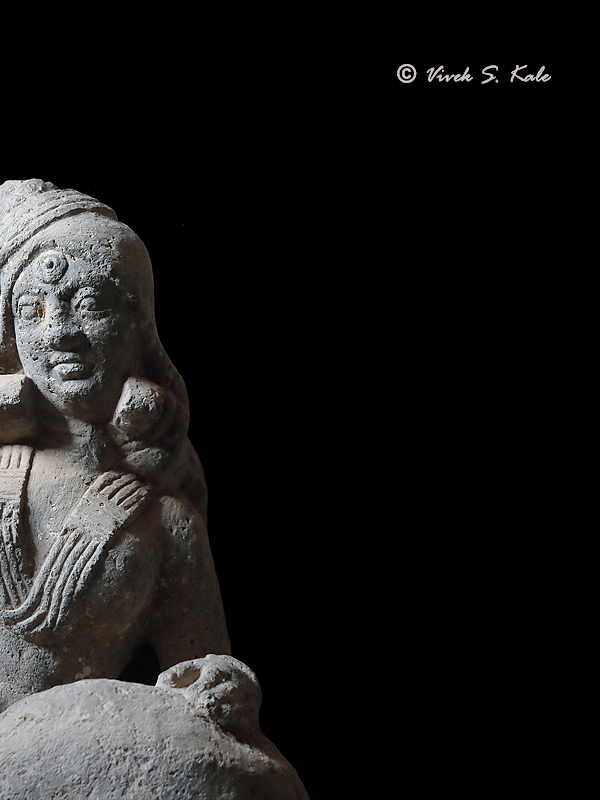 |
| |
| 6. Pillar L1, Chaityagriha, Karle Caves, Maval Tehsil, Pune district, Maharashtra, India |
| |
|
|
| |
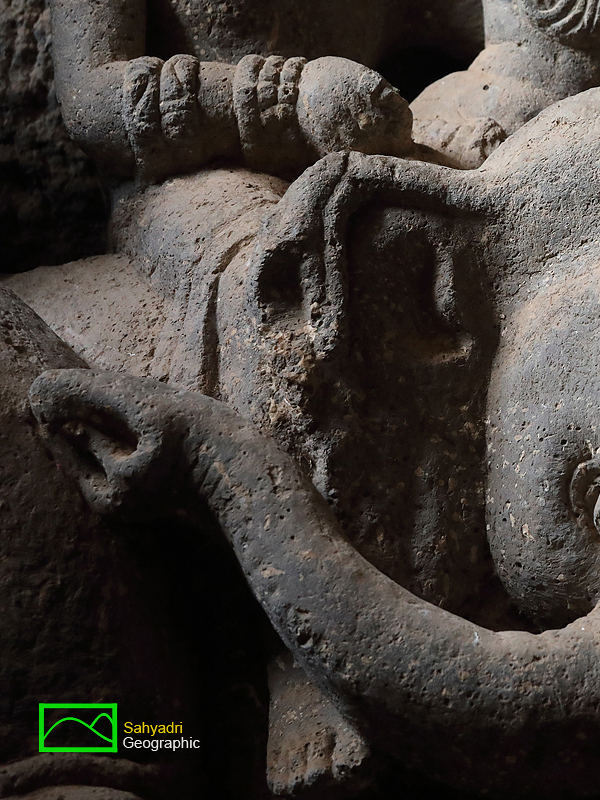 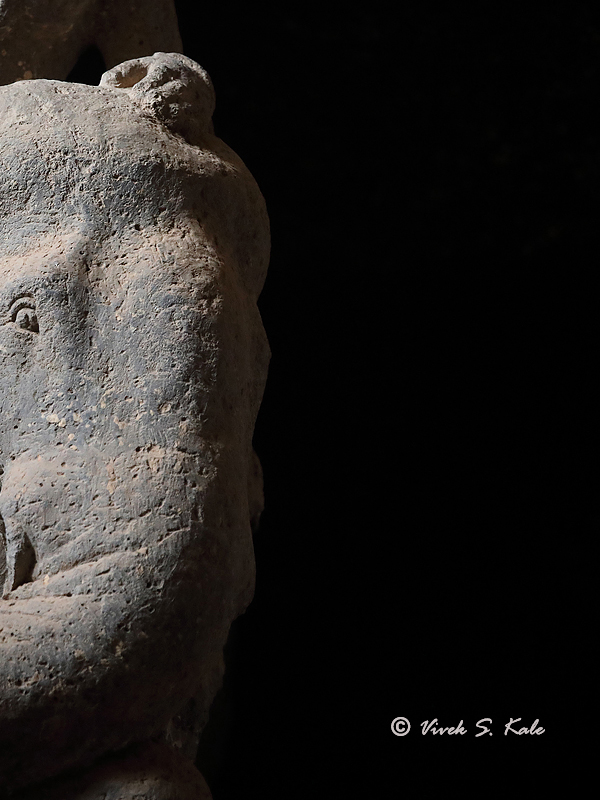 |
| |
| 7. Pillar L1, Chaityagriha, Karle Caves, Maval Tehsil, Pune district, Maharashtra, India
|
| |
|
|
| |
  |
| |
| 8. Pillar L2, Chaityagriha, Karle Caves, Maval Tehsil, Pune district, Maharashtra, India |
| |
|
|
छायाचित्रात दुसरा अष्टकोनी खांब (डाव्या रांगेतील/ उत्तरेकडील) दाखविलेला आहे. यात खांबावरची पुढच्या बाजुची शिल्पे दाखविलेली आहेत. या शिल्पात दोन हत्ती आहेत. दोन्ही हत्तींवर स्त्री-पुरुष जोड़्या आरुढ झालेल्या आहेत. या शिल्पांत हातातील कडी/बांगड़्या व्यतिरिक्त इतर आभुषणे दाखविलेली नाहीत. या खांबाच्या मागच्या बाजूस स्त्री-पुरुष जोड़्या घोड़्यांवर आरुढ झालेले पहावयास मिळतात. भारतीय पगडी/फेटा न परिधान केलेले पुरुष व्यक्ती या शिल्पात दाखविलेले आहेत. कदाचित हे यवन किंवा शक असण्याची शक्यता आहे.
|
|
Second octagonal pillar, (with sculptures on its capital) on left hand side (person facing stupa) i.e. on north side in Karla Chaityagriha is shown in the image. In this image, only the sculptures facing the main hall are highlighted and the image does not show the other details such as top of the pillar, backside of the pillar and wall behind. On both the elephants, human pair of male and female are riding. Interesting to see that these riders do not have much ornaments except the wrist bracelets. This pillar has male and female human riders riding on bull and horse on the alley side (back side). Some of the male riders do not have headgears and may be representations of people from western civilisations such as greek or Indo sythians.
|
|
|
| |
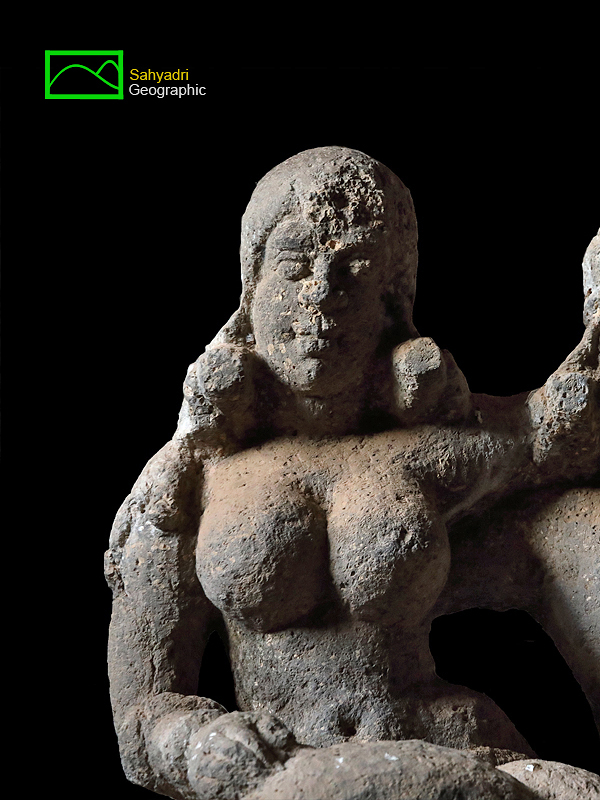 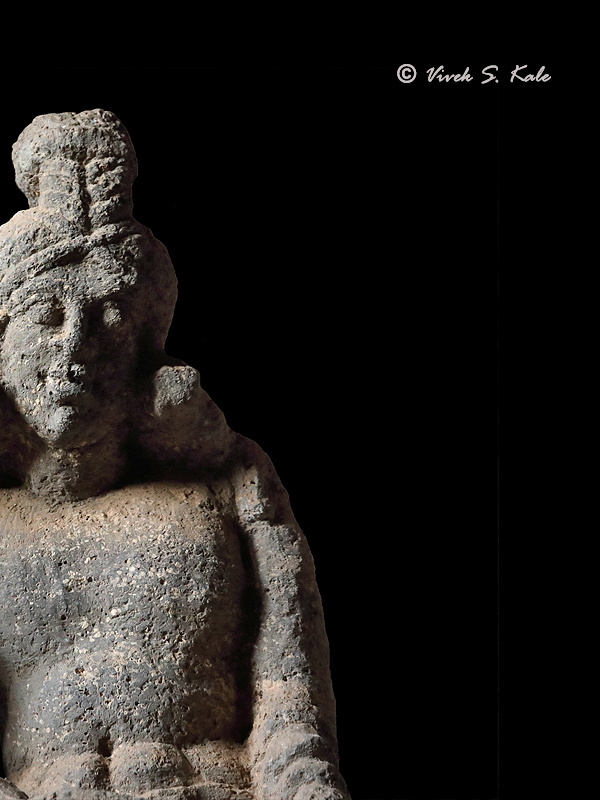 |
| |
| 9. Pillar L2, Chaityagriha, Karle Caves, Maval Tehsil, Pune district, Maharashtra, India |
| |
|
|
| |
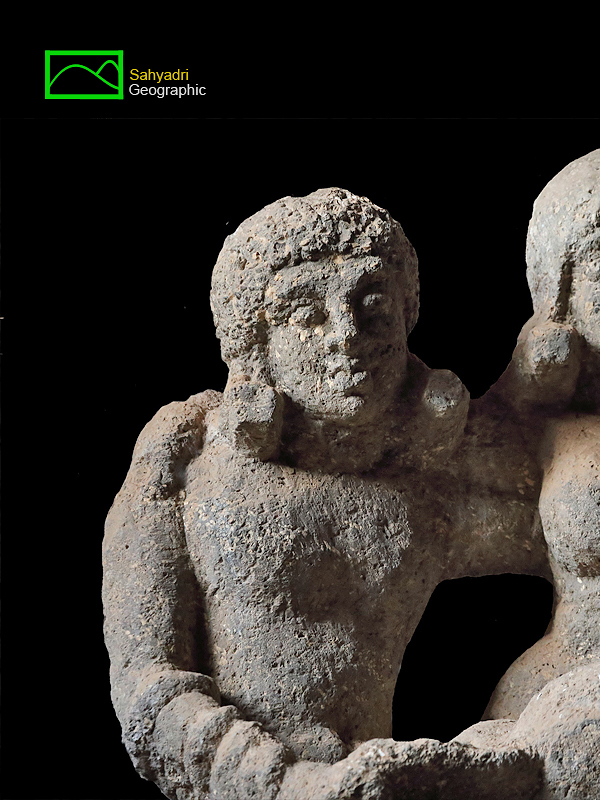 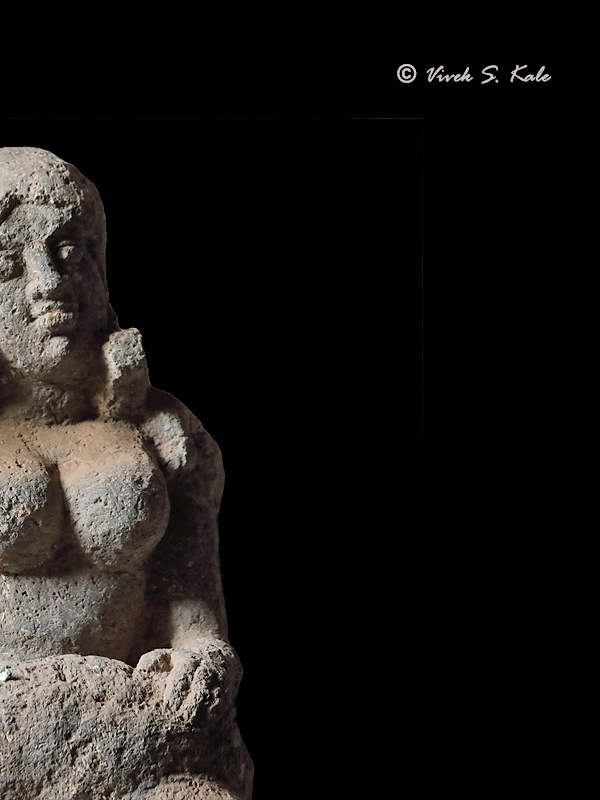 |
| |
| 10. Pillar L2, Chaityagriha, Karle Caves, Maval Tehsil, Pune district, Maharashtra, India |
| |
|
|
| |
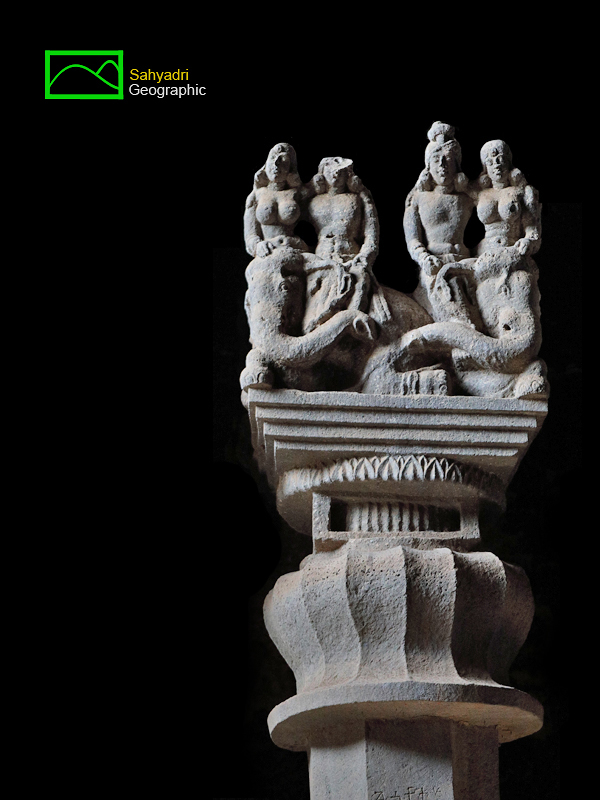  |
| |
| 11. Pillar L3, Chaityagriha, Karle Caves, Maval Tehsil, Pune district, Maharashtra, India |
| |
|
|
छायाचित्रात तिसरा अष्टकोनी खांब (डाव्या रांगेतील/ उत्तरेकडील) दाखविलेला आहे. यात खांबावरची पुढच्या बाजुची शिल्पे दाखविलेली आहेत. या शिल्पात दोन हत्ती आहेत. दोन्ही हत्तींवर स्त्री-पुरुष जोड़्या आरुढ झालेल्या आहेत.
स्त्री शिल्पात बांगड़्या आणि कपाळावरचे आभूषण (टिका) ही आभुषणे आहेत. पुरुष शिल्पाच्या हातात कडे आहेत. स्त्री आणि पुरुष पारंपारिक परिवेषात आहेत. या खांबाच्या मागच्या बाजूस स्त्री-पुरुष जोड़्या बैल आणि घोड़्यावर आरुढ झालेले पहावयास मिळतात.
या खांबावर एक शिलालेख आहे. हा शिलालेख पाली भाषेत ब्राह्मी लिपीत कोरलेला आहे.
शिलालेखाचे मराठी भाषांतर : “धेनुकाकट च्या धम्म यवनाकडुन [दान]”
|
|
Third octagonal pillar, (with sculptures on its capital) on left hand side (person facing stupa) i.e. on north side in Karla Chaityagriha is shown in the image. In this image, only the sculptures facing the main hall are highlighted and the image does not show the other details such as top of the pillar, backside of the pillar and wall behind. On both the elephants a human pairs of male and female are riding.
Interesting ornaments such as wrist bracelets and forehead jewelry can be seen here on the female riders. The wrist bracelet can also be seen on the male rider. The elephant riders are dressed traditionally. This pillar has male and female human riders riding on bull and horse on the alley side (back side). This pillar has Prakrit inscription in Brahmi script. The meaning of the inscription is, “ (The gift) of Dhama, a Yavana from Dhenukakata"
|
|
|
| |
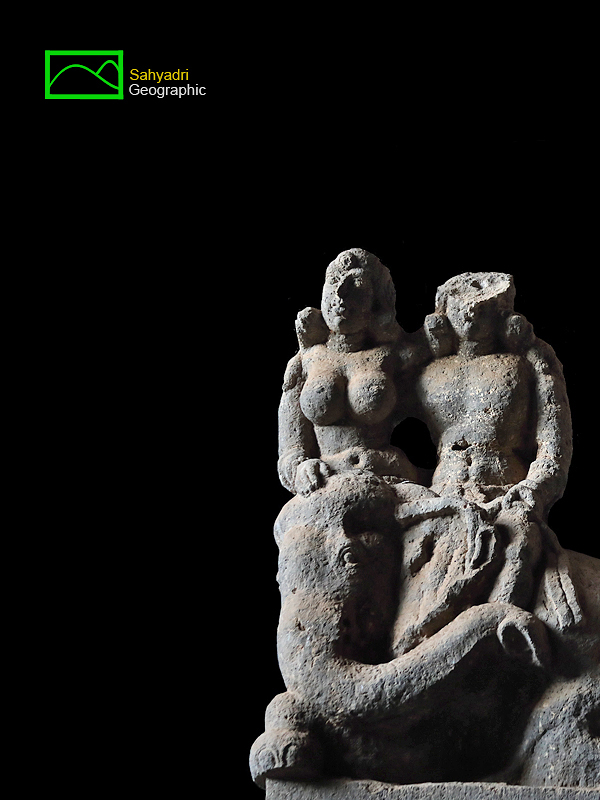  |
| |
| 12. Pillar L3, Chaityagriha, Karle Caves, Maval Tehsil, Pune district, Maharashtra, India |
| |
|
|
| |
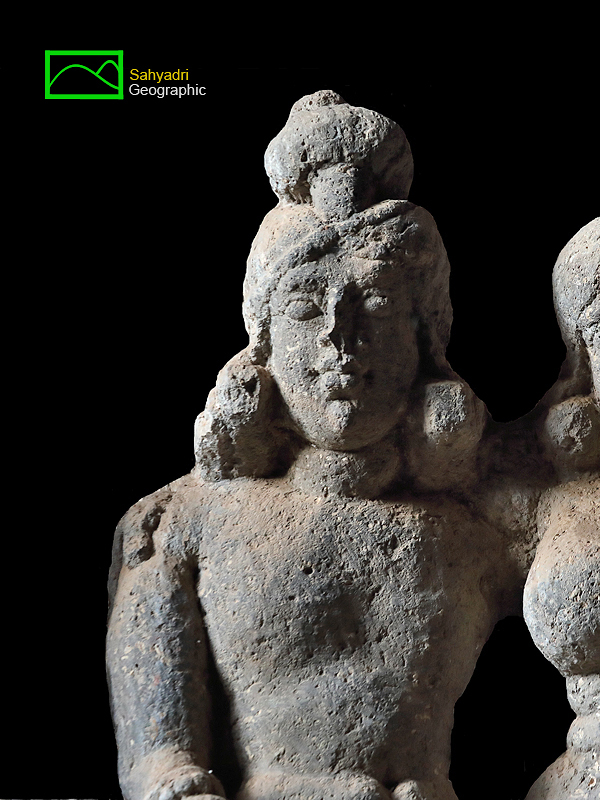  |
| |
| 13. Pillar L3, Chaityagriha, Karle Caves, Maval Tehsil, Pune district, Maharashtra, India |
| |
|
|
| |
  |
| |
| 14. Inscription on Pillar L3, Chaityagriha, Karle Caves, Maval Tehsil, Pune district, Maharashtra, India |
| |
|
|
धेनुकाकटा
धमयवनस
शिलालेखाचे मराठी भाषांतर : “धेनुकाकट च्या धम्म यवनाकडुन [दान]”
धेनुकाकट : ठिकाणाचे नाव, धम : देणगीदाराचे नाव , यवन : ग्रीक
|
|
Dhenukākatā
Dhammayavanasa
Meaning in English :
"(The gift) of Dhama, a Yavana from Dhenukakata“ (Reference 2)
Dhenukakat : Name of the place, Dhama : Name of the donor, Yavana : Greek /Indo Baktrian.
|
|
|
| |
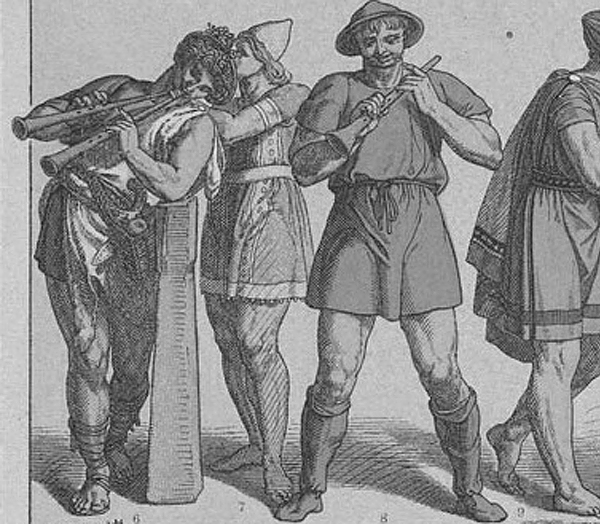 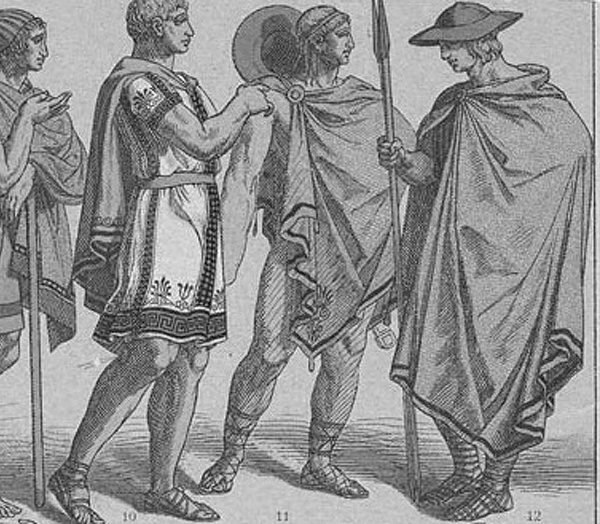 |
| |
| 15. Greeks |
| |
|
|
| |
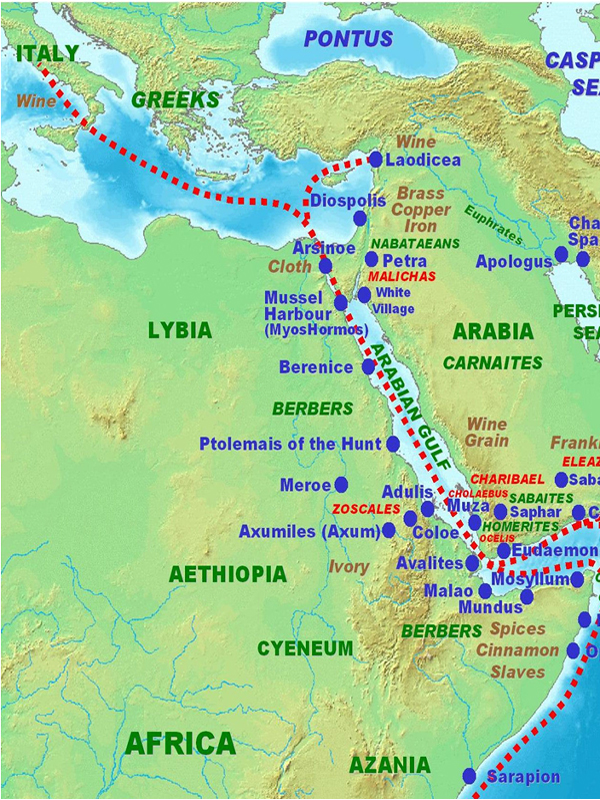 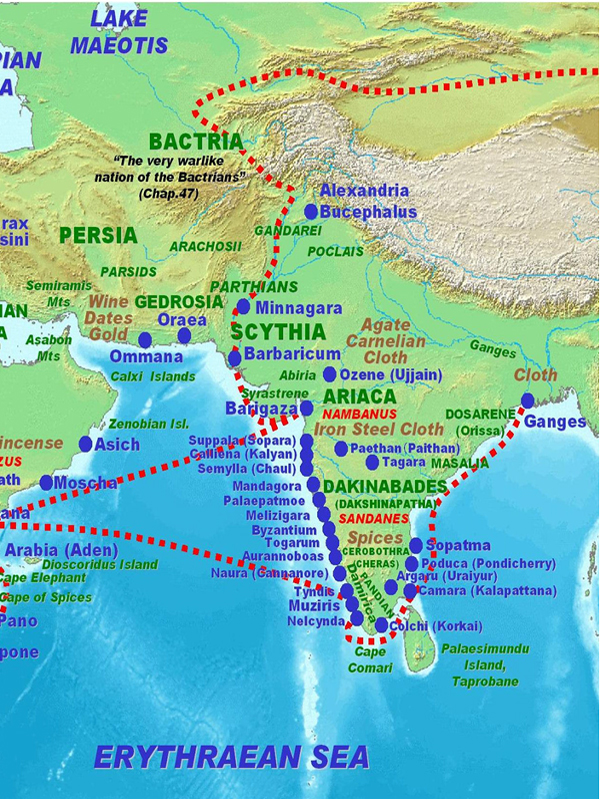 |
| |
| 16. Ancient Indo Greek Trade route through Kalyan and Sopara |
| |
|
|
कल्याण आणि सोपारा ही प्राचिन बंदरे, भारत आणि ग्रीक राज्यांमध्ये समुद्रमार्गे व्यापारासाठी वापरात होती. व्यापारी मार्गावर कार्ले लेणी समुह आहे. कार्ले चैत्यगृहात विविध शिलालेखात नमुद केल्याप्रमाणे, येथील मठाला त्याकाळात ग्रीक व्यापाऱ्यांनी दान दिलेले आहे. यातील काही ग्रीक माणस, धेनुकाकटा या गावातील होती. हे गाव कुठे होते हे अजुनही मोठे कोडे आहे. विविध अभ्यासकांनी या गावाबाबत वेगवेगळे तर्क मांडले आहेत.
|
|
The Kalyan and Sopara ports were used for trading with Greek. These ports were linked with the various trade centers on deccan plateau via Bor ghat. The Karle Cave complex is located near this trade route. The various greek people from unknown town of Dhenukakata have given the donations to Karle Monastry. The exact location of Dhenukakata is not known today and it remains the mystery.
|
|
|
| |
 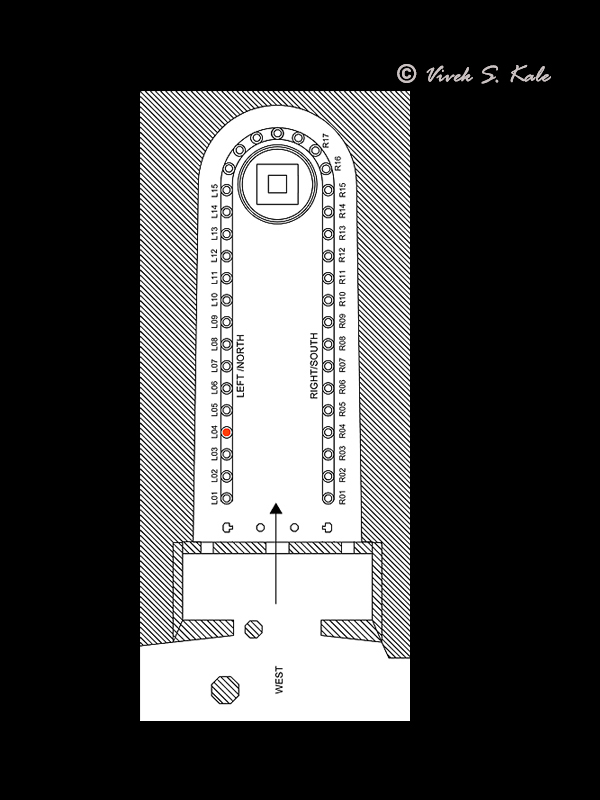 |
| |
| 17. Pillar L4, Chaityagriha, Karle Caves, Maval Tehsil, Pune district, Maharashtra, India |
| |
|
|
छायाचित्रात चौथा अष्टकोनी खांब (डाव्या रांगेतील/ उत्तरेकडील) दाखविलेला आहे. यात खांबावरची पुढच्या बाजुची शिल्पे दाखविलेली आहेत. या शिल्पात दोन हत्ती आहेत. एका हत्तीवर स्त्री-पुरुष जोडी आरुढ झालेली आहे. तर दुस्रया हत्तीवर दोन स्त्रीया आरुढ झालेल्या आहेत. स्त्री शिल्पात कंबरपट्टा, बांगड़्या आणि कपाळावरचे आभूषण (टिका) ही आभुषणे आहेत. पुरुष शिल्पाच्या हातात कडे आहेत. स्त्री आणि पुरुष पारंपारिक परिवेषात आहेत. या खांबाच्या मागच्या बाजूस स्त्री-पुरुष जोड़्या बैल आणि घोड़्यावर आरुढ झालेले पहावयास मिळतात.
खांबावर दोन शिलालेख आहेत. हे शिलालेख पाली भाषेत ब्राह्मी लिपीत कोरलेले आहे. शिलालेखांचे मराठी भाषांतर "धेनुकाकट च्या सिहध्यान यवनाकडुन स्तंभाकरिता दान." आणि “ धेनुकाकट च्या सिहध्यान यवनाकडुन स्तंभाकरिता दान." असे आहे.
|
|
Fourth octagonal pillar, (with sculptures on its capital) on left hand side (person facing stupa) i.e. on north side in Karla Chaityagriha is shown in the image. In this image, only the sculptures facing the main hall are highlighted and the image does not show the other details such as top of the pillar, backside of the pillar and wall behind. On one of the elephants a human pair of male and female is riding. On the other elephant other human pair of female riders can be seen. Interesting ornaments such as waist jewelry, wrist bracelets and forehead jewelry can be seen here on the female riders. The wrist bracelet can be seen on the male rider. This pillar has male and female human riders riding on bull and horse on the alley side (back side). This pillar has two prakrit inscriptions in Brahmi script. The meaning of the inscription is, “The gift of a pillar by Sihadhaya, a Yavana, from Dhenukakata“ and "The gift of a pillar by Sihadhaya, a Yavana, from Dhenukakata"
|
|
|
| |
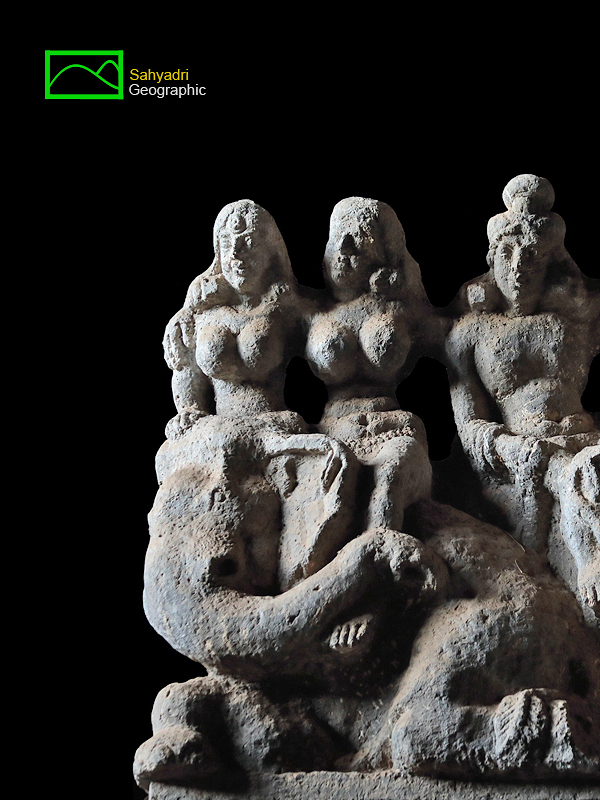  |
| |
| 18. Pillar L4, Chaityagriha, Karle Caves, Maval Tehsil, Pune district, Maharashtra, India |
| |
|
|
| |
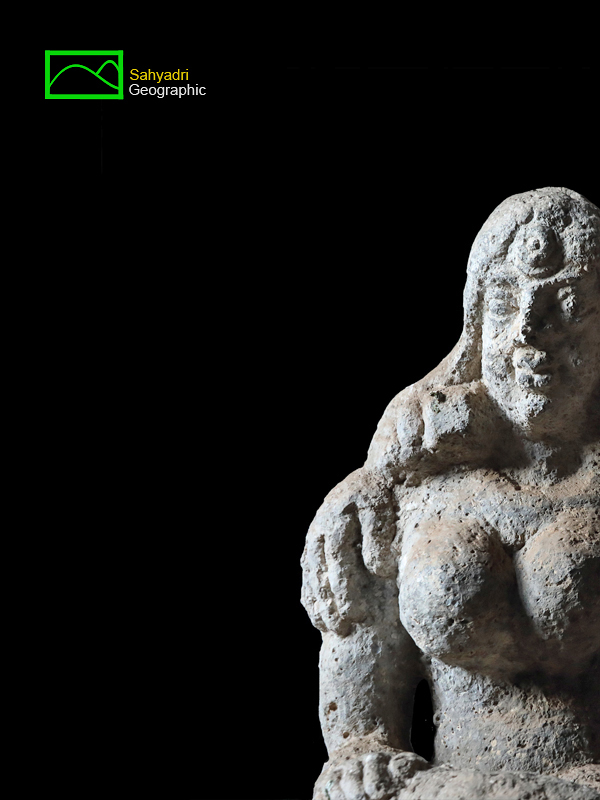 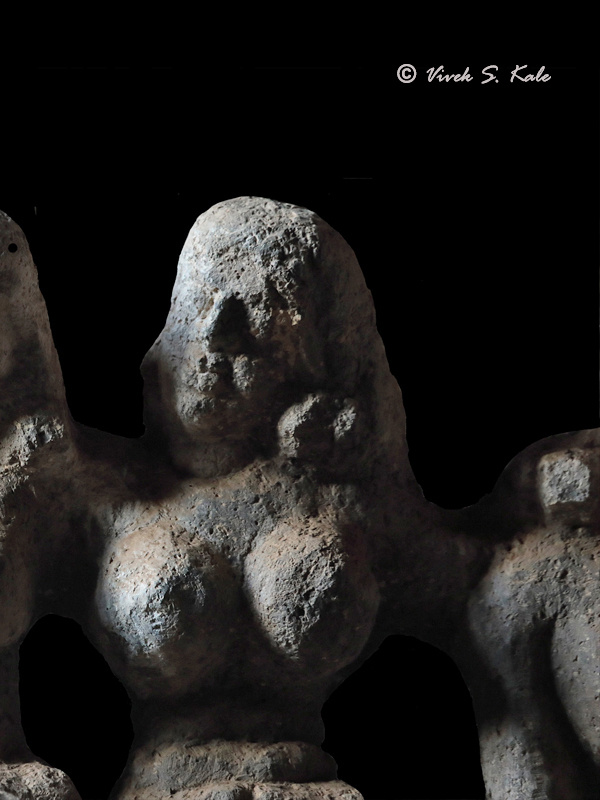 |
| |
| 19. Pillar L4, Chaityagriha, Karle Caves, Maval Tehsil, Pune district, Maharashtra, India |
| |
|
|
| |
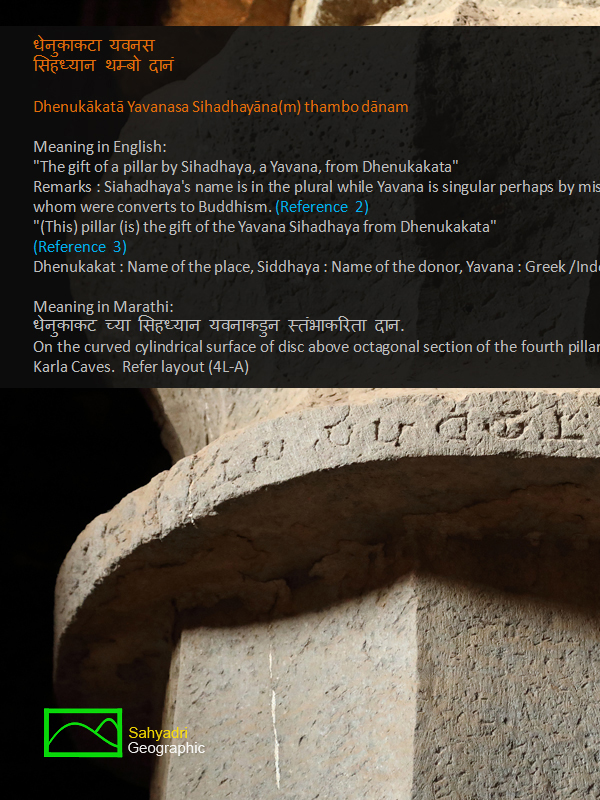 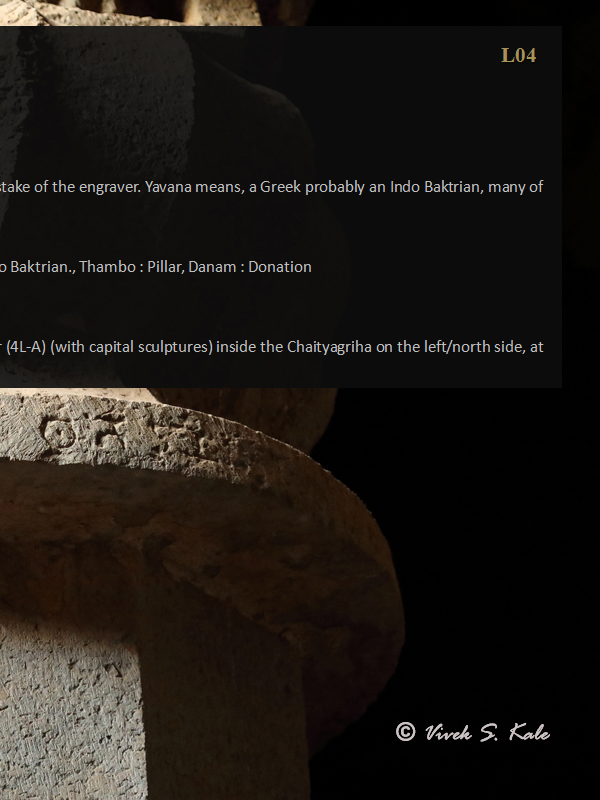 |
| |
| 20. Inscription at Pillar L4, Chaityagriha, Karle Caves, Maval Tehsil, Pune district, Maharashtra, India |
| |
|
|
शिलालेखांचे मराठी भाषांतर
धेनुकाकटा यवनस
सिहध्यान थम्बो दानं
धेनुकाकट च्या सिहध्यान यवनाकडुन स्तंभाकरिता दान.
धेनुकाकट : ठिकाणाचे नाव, सिहध्यान : देणगीदाराचे नाव , यवन : ग्रीक, थंबो : खांब
|
|
Dhenukākatā Yavanasa Sihadhayāna(m) thambo dānam
Meaning in English:
"The gift of a pillar by Sihadhaya, a Yavana, from Dhenukakata"
Remarks : Siahadhaya's name is in the plural while Yavana is singular perhaps by mistake of the engraver. Yavana means, a Greek probably an Indo Baktrian, many of whom were converts to Buddhism. (Reference 2)
"(This) pillar (is) the gift of the Yavana Sihadhaya from Dhenukakata"
(Reference 3)
Dhenukakat : Name of the place, Siddhaya : Name of the donor, Yavana : Greek /Indo Baktrian., Thambo : Pillar, Danam : Donation
|
|
|
| |
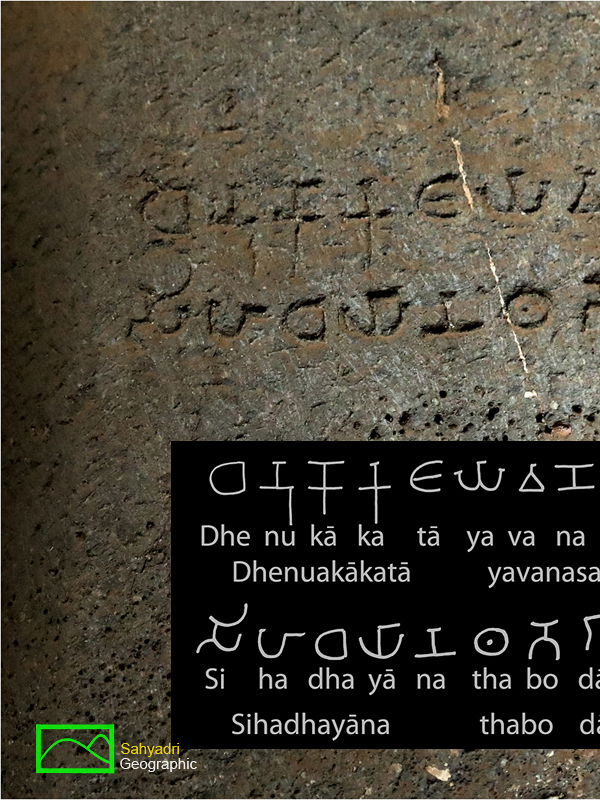 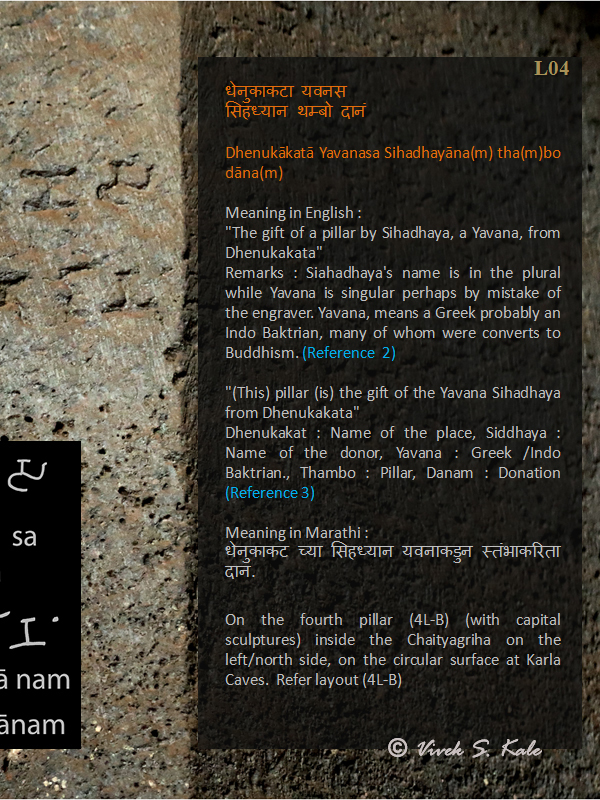 |
| |
| 21. Inscription at Pillar L4, Chaityagriha, Karle Caves, Maval Tehsil, Pune district, Maharashtra, India |
| |
|
|
शिलालेखांचे मराठी भाषांतर
धेनुकाकटा यवनस
सिहध्यान थम्बो दानं
धेनुकाकट च्या सिहध्यान यवनाकडुन स्तंभाकरिता दान.
धेनुकाकट : ठिकाणाचे नाव, सिहध्यान : देणगीदाराचे नाव , यवन : ग्रीक, थंबो : खांब
|
|
Dhenukākatā Yavanasa Sihadhayāna(m) tha(m)bo dāna(m)
Meaning in English :
"The gift of a pillar by Sihadhaya, a Yavana, from Dhenukakata"
Remarks : Siahadhaya's name is in the plural while Yavana is singular perhaps by mistake of the engraver. Yavana, means a Greek probably an Indo Baktrian, many of whom were converts to Buddhism. (Reference 2)
"(This) pillar (is) the gift of the Yavana Sihadhaya from Dhenukakata"
Dhenukakat : Name of the place, Siddhaya : Name of the donor, Yavana : Greek /Indo Baktrian., Thambo : Pillar, Danam : Donation (Reference 3)
|
|
|
| |
  |
| |
| 22. Pillar L5, Chaityagriha, Karle Caves, Maval Tehsil, Pune district, Maharashtra, India |
| |
|
|
छायाचित्रात पाचवा अष्टकोनी खांब (डाव्या रांगेतील/ उत्तरेकडील) दाखविलेला आहे. यात खांबावरची पुढच्या बाजुची शिल्पे दाखविलेली आहेत. या शिल्पात दोन हत्ती आहेत. दोन्ही हत्तींवर स्त्री-पुरुष जोड़्या आरुढ झालेल्या आहेत.
स्त्री शिल्पात गळ्यातला हार, बांगड़्या आणि कपाळावरचे आभूषण (टिका) ही आभुषणे आहेत. पुरुष शिल्पाच्या हातात कडे आहेत. स्त्री आणि पुरुष पारंपारिक परिवेषात आहेत.
या खांबाच्या मागच्या बाजूस स्त्री-पुरुष जोड़्या बैल आणि घोड़्यावर आरुढ झालेले पहावयास मिळतात.
या खांबावर दोन शिलालेख आहेत. हे शिलालेख पाली भाषेत ब्राह्मी लिपीत कोरलेले आहे. शिलालेखांचे मराठी भाषांतर " धेनुकाकट च्या सिहध्यान यवनाकडुन स्तंभाकरिता दान. " आणि " भदंत धमुतराया यांचा अनुयायी आणी भदंतांच्या बहिणीचा पुत्र, नंदाचा पुत्र, सोपारकाचा सतिमित (आपल्या आई व वडिलांबरोबर) याच्याकडुन त्याचे मामा भदंत धमुतराया यांच्या आदरातीर्थ्य स्तंभासाठी दान.
" असे आहे. या खांबावर वरच्या बाजुस दोन चिन्हे आहेत. एका बाजुस १६ आरे असलेले अशोकचक्र (धर्मचक्र) एका खांबावर दाखवलेले आहे. दुसऱ्या बाजुस सिंह आरुढ असलेले सिंहस्तंभ कोरलेल आहे.
|
|
Fifth octagonal pillar, (with sculptures on its capital) on left hand side (person facing stupa) i.e. on north side in Karla Chaityagriha is shown in the image. In this image, only the sculptures facing the main hall are highlighted and the image does not show the other details such as top of the pillar, backside of the pillar and wall behind. On both the elephants a human pairs of male and female are riding. Interesting ornaments such as waist jewelry, necklace and forehead jewelry can be seen here on the female rider. The wrist bracelet can be seen on the male rider. This pillar has male and female human riders riding on bull and horse on the alley side (back side). This pillar has Prakrit inscription in Brahmi script. The meaning of the inscription is, "The gift of the cost of a pillar by Satimita from Soparaka, out of respect for his maternal uncle the Bhadanta Dhamutaraya, by his (i.e. Bahdanata's) desciple and sister's son Satimita, the son of Nanda, with his mother and father.“ and "The gift of a pillar containing relics by Satimita from Soparaka sister's son of Bhadanta Dhamutaraya“ respectively. The pillar has additional symbols on the capital facing east and west. There is a Dhamma Chakra with 16 arms facing east and there is a pillar symbol with a lion atop facing west.
|
|
|
| |
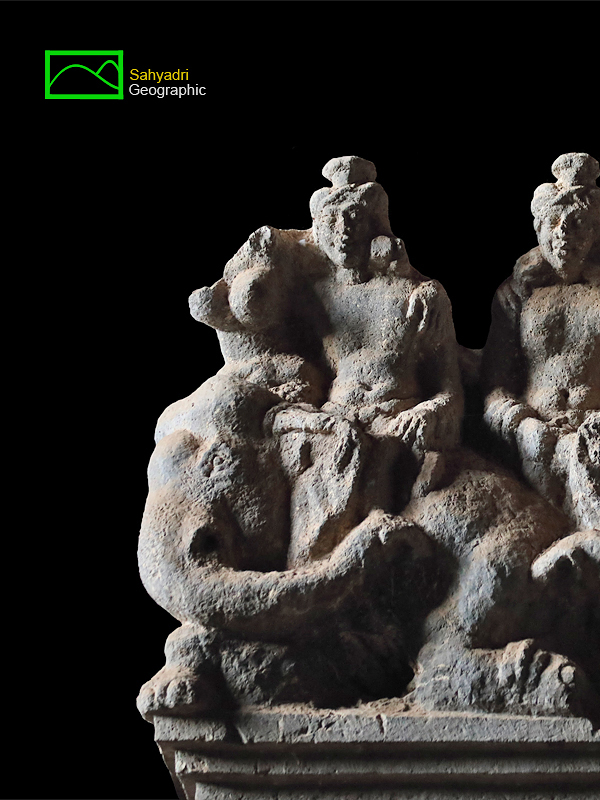 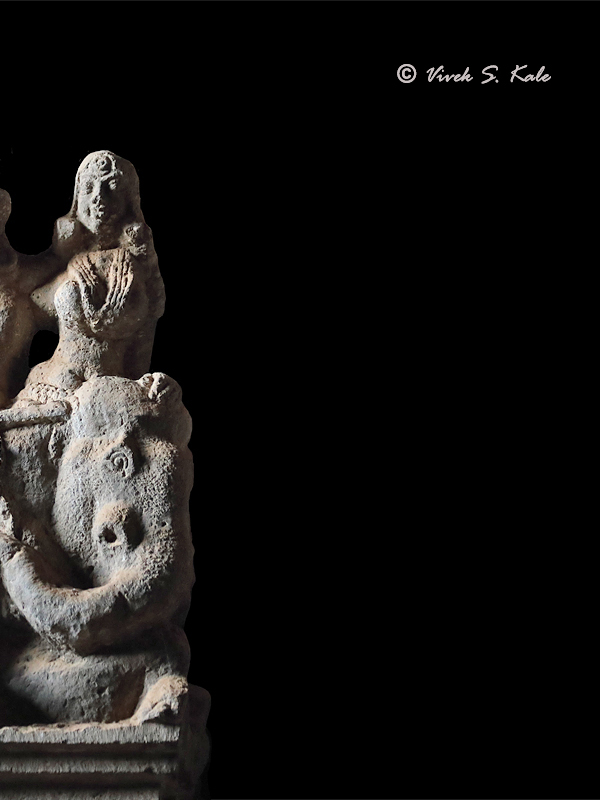 |
| |
| 23. Pillar L5, Chaityagriha, Karle Caves, Maval Tehsil, Pune district, Maharashtra, India |
| |
|
|
| |
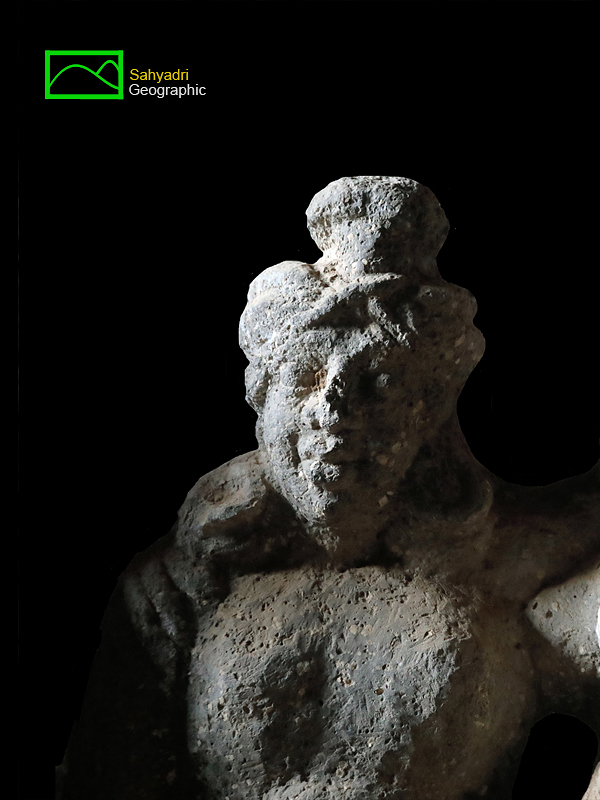 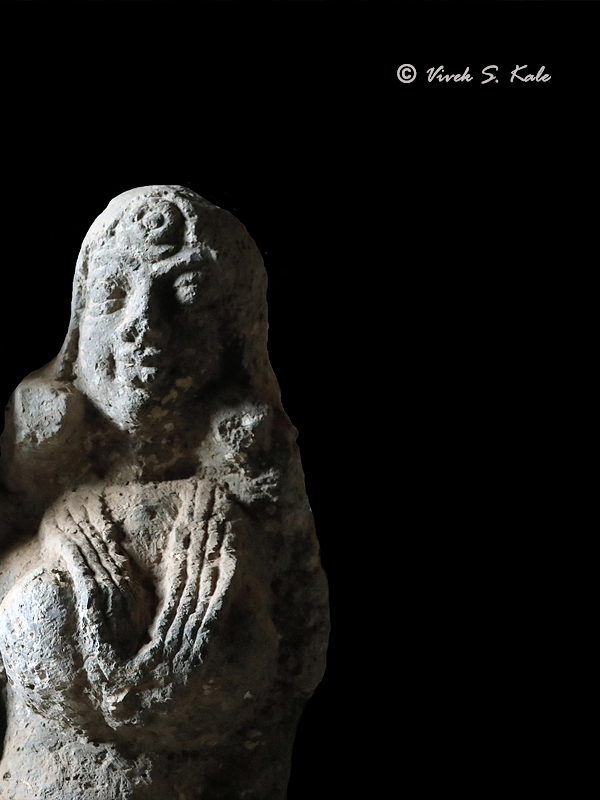 |
| |
| 24. Pillar L5, Chaityagriha, Karle Caves, Maval Tehsil, Pune district, Maharashtra, India |
| |
|
|
| |
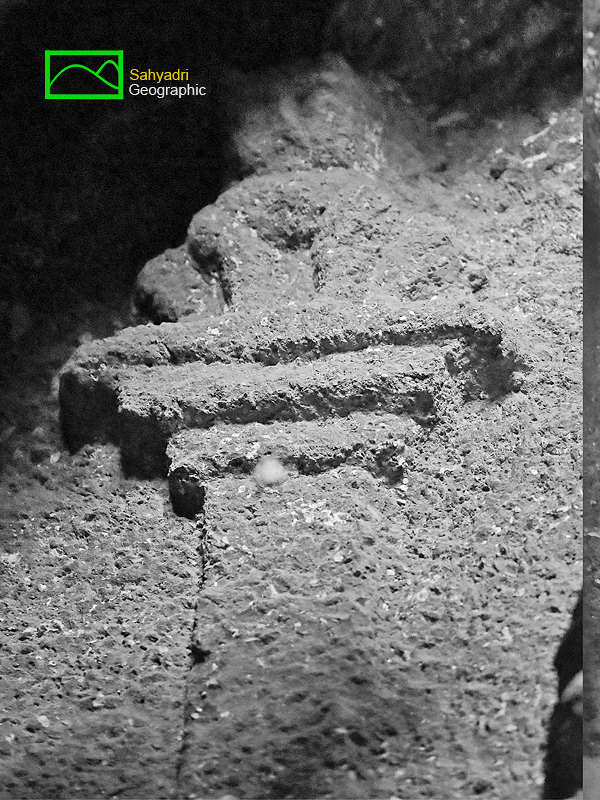 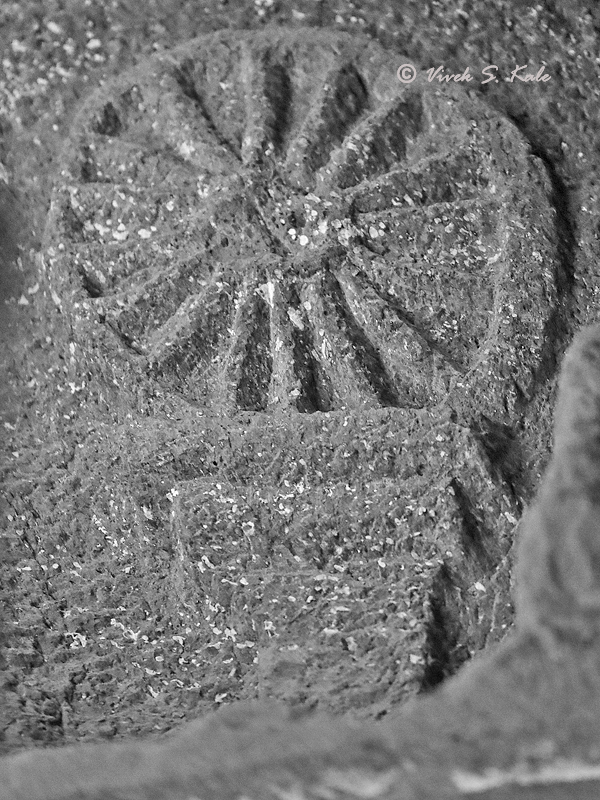 |
| |
| 25. Pillar L5, Chaityagriha, Karle Caves, Maval Tehsil, Pune district, Maharashtra, India |
| |
|
|
| |
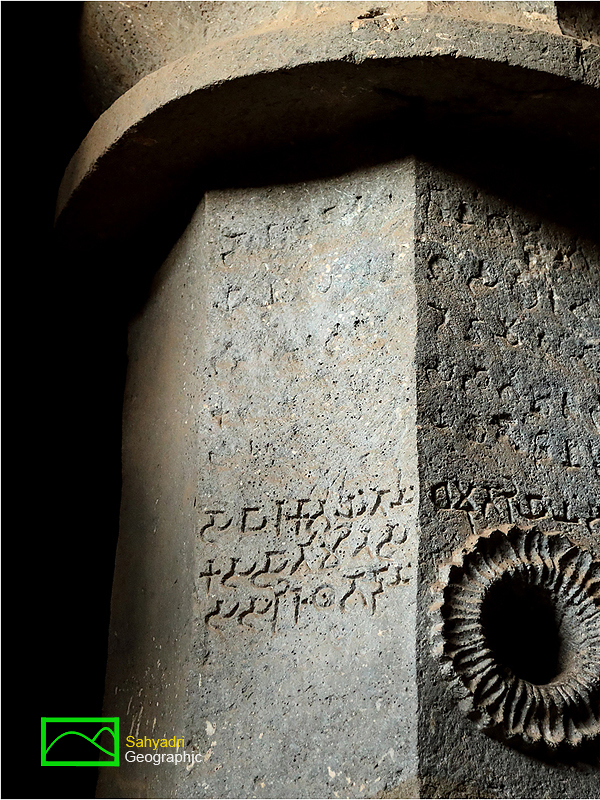 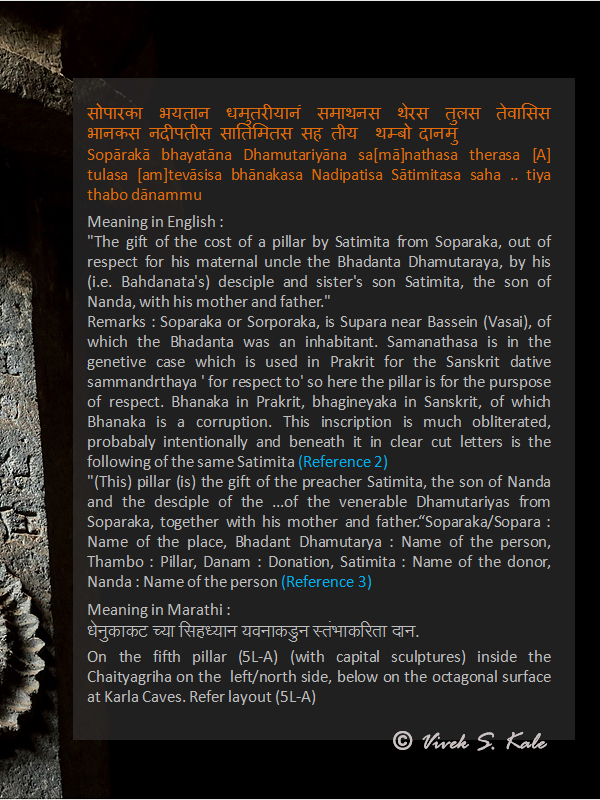 |
| |
| 26. Inscription at Pillar L5, Chaityagriha, Karle Caves, Maval Tehsil, Pune district, Maharashtra, India |
| |
|
|
सोपारका भयतान धमुतरीयानं समाथनस थेरस तुलस तेवासिस भानकस नदीपतीस सातिमितस सह तीय थम्बो दानमु
शिलालेखांचे मराठी भाषांतर
धेनुकाकट च्या सिहध्यान यवनाकडुन स्तंभाकरिता दान.
सोपारका : ठिकाणाचे नाव (आजचे नालासोपारा) हे गाव समुद्राजवळचे महत्वाचे बंदर होते. .
धमुतारीया : बुद्ध पंथ, सतिमित : माणसाचे नाव, नंदा :माणसाचे नाव, भदंत धमुतारीया : माणसाचे नाव, .
यवन : ग्रीक, थंबो : खांब .
हा शिलालेख खोडलेला आहे. त्याखाली त्याच संदर्भातला दुसरा शिलालेख कोरलेला आहे.
|
|
Sopārakā bhayatāna Dhamutariyāna sa[mā]nathasa therasa [A] tulasa [am]tevāsisa bhānakasa Nadipatisa Sātimitasa saha .. tiya thabo dānammu
Meaning in English :
"The gift of the cost of a pillar by Satimita from Soparaka, out of respect for his maternal uncle the Bhadanta Dhamutaraya, by his (i.e. Bahdanata's) desciple and sister's son Satimita, the son of Nanda, with his mother and father."
Remarks : Soparaka or Sorporaka, is Supara near Bassein (Vasai), of which the Bhadanta was an inhabitant. Samanathasa is in the genetive case which is used in Prakrit for the Sanskrit dative sammandrthaya ' for respect to' so here the pillar is for the purspose of respect. Bhanaka in Prakrit, bhagineyaka in Sanskrit, of which Bhanaka is a corruption. This inscription is much obliterated, probabaly intentionally and beneath it in clear cut letters is the following of the same Satimita (Reference 2)
"(This) pillar (is) the gift of the preacher Satimita, the son of Nanda and the desciple of the ...of the venerable Dhamutariyas from Soparaka, together with his mother and father.“Soparaka/Sopara : Name of the place, Bhadant Dhamutarya : Name of the person, Thambo : Pillar, Danam : Donation, Satimita : Name of the donor, Nanda : Name of the person (Reference 3)
|
|
|
| |
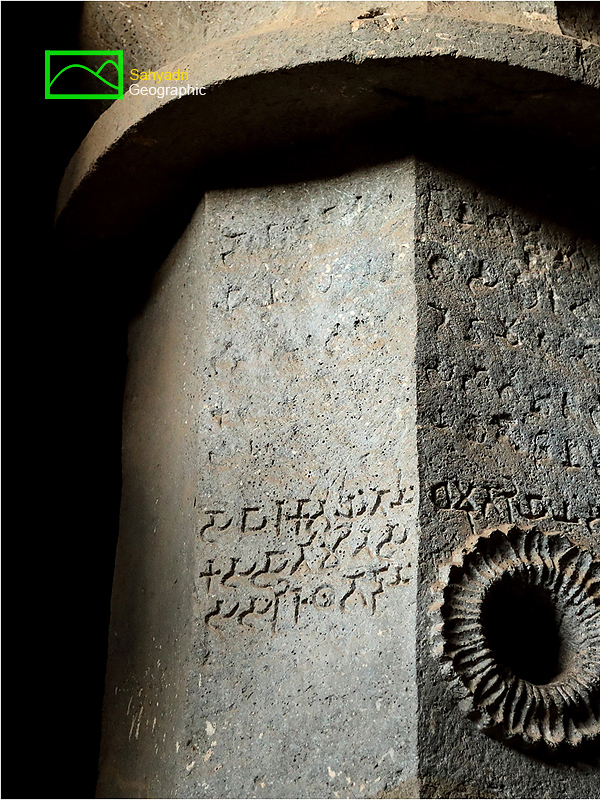 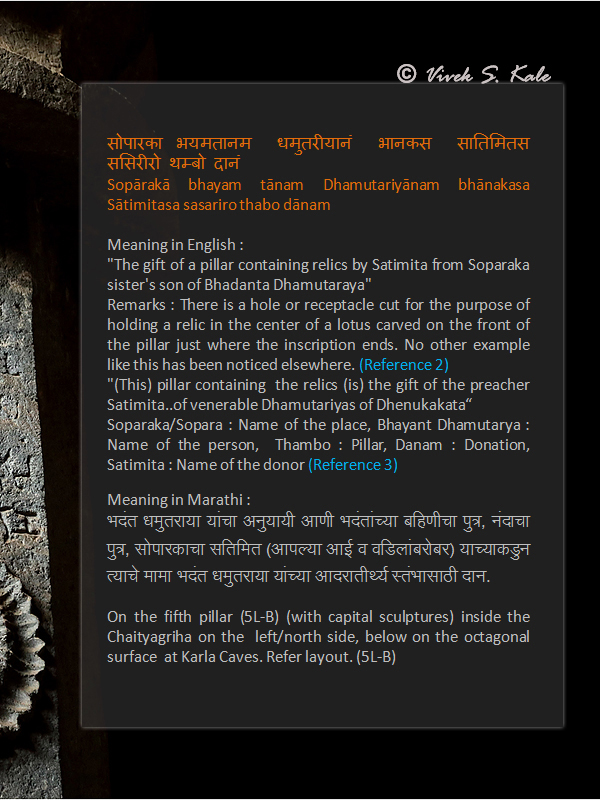 |
| |
| 27. Inscription at Pillar L5, Chaityagriha, Karle Caves, Maval Tehsil, Pune district, Maharashtra, India |
| |
|
|
सोपारका भयमतानम धमुतरीयानं भानकस सातिमितस ससिरीरो थम्बो दानं
शिलालेखांचे मराठी भाषांतर :
भदंत धमुतराया यांचा अनुयायी आणी भदंतांच्या बहिणीचा पुत्र, नंदाचा पुत्र, सोपारकाचा सतिमित (आपल्या आई व वडिलांबरोबर) याच्याकडुन त्याचे मामा भदंत धमुतराया यांच्या आदरातीर्थ्य स्तंभासाठी दान.
सोपारका : ठिकाणाचे नाव (आजचे नालासोपारा) हे गाव समुद्राजवळचे महत्वाचे बंदर होते. .
धमुतारीया : बुद्ध पंथ, सतिमित : माणसाचे नाव, नंदा :माणसाचे नाव, भदंत धमुतारीया : माणसाचे नाव, .
यवन : ग्रीक, थंबो : खांब .
या शिलालेखाजवळ एक कमळ कोरलेले आहे. कमळाच्या मध्यभागी एक खड्डा आहे. यात कदाचित भदंत धमुसरिया या उपासकाचे शारीरिक अवशेष लहान कलशात ठेवले असावेत.
|
|
Sopārakā bhayam tānam Dhamutariyānam bhānakasa Sātimitasa sasariro thabo dānam
Meaning in English :
"The gift of a pillar containing relics by Satimita from Soparaka sister's son of Bhadanta Dhamutaraya"
Remarks : There is a hole or receptacle cut for the purpose of holding a relic in the center of a lotus carved on the front of the pillar just where the inscription ends. No other example like this has been noticed elsewhere. (Reference 2)
"(This) pillar containing the relics (is) the gift of the preacher Satimita..of venerable Dhamutariyas of Dhenukakata“
Soparaka/Sopara : Name of the place, Bhayant Dhamutarya : Name of the person, Thambo : Pillar, Danam : Donation, Satimita : Name of the donor (Reference 3)
|
|
|
| |
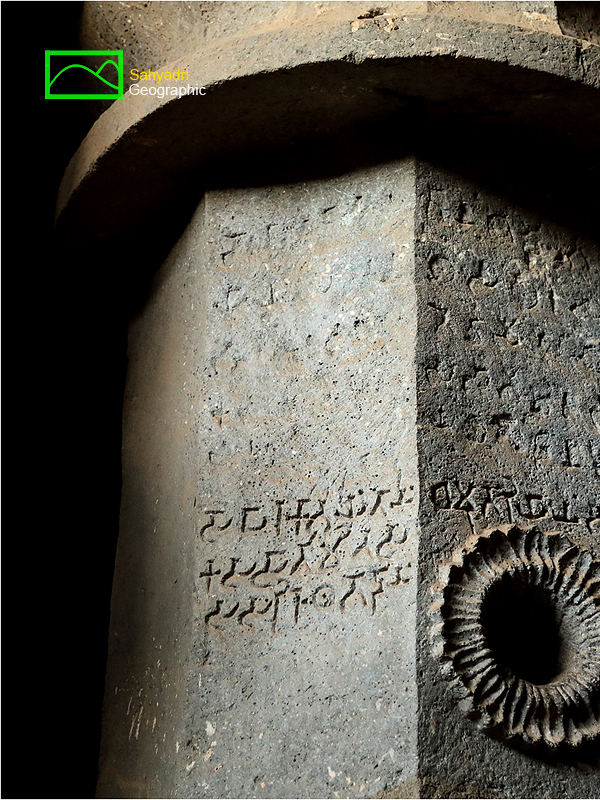 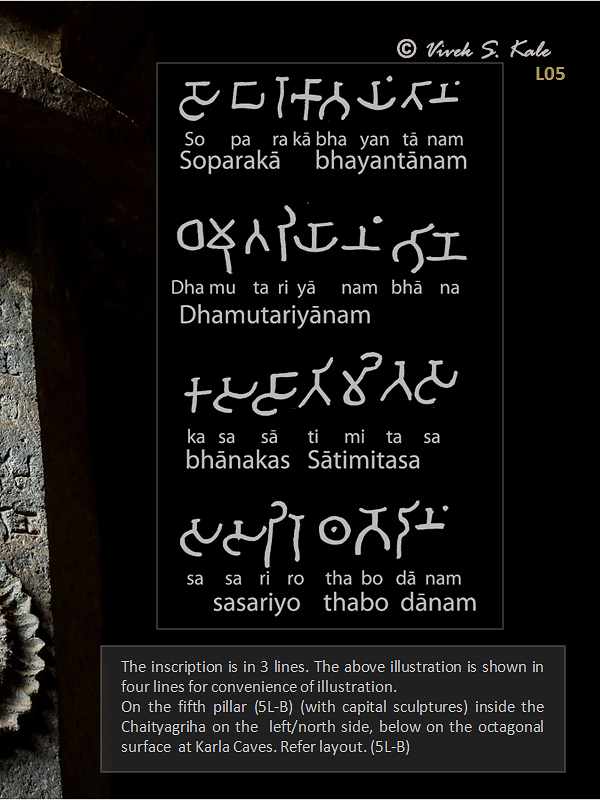 |
| |
| 28. Inscription at Pillar L5, Chaityagriha, Karle Caves, Maval Tehsil, Pune district, Maharashtra, India |
| |
|
|
| |
 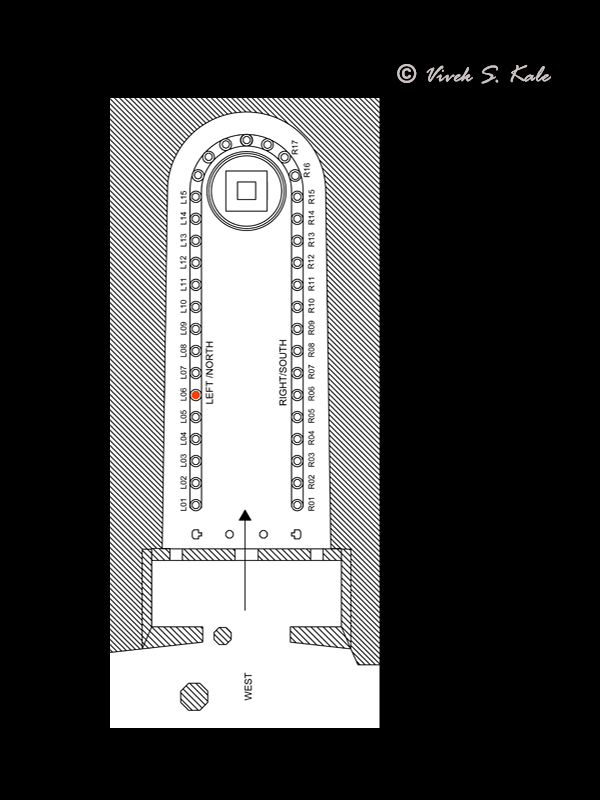 |
| |
| 29. Pillar L6, Chaityagriha, Karle Caves, Maval Tehsil, Pune district, Maharashtra, India |
| |
|
|
छायाचित्रात सहावा अष्टकोनी खांब (डाव्या रांगेतील/ उत्तरेकडील) दाखविलेला आहे. यात खांबावरची पुढच्या बाजुची शिल्पे दाखविलेली आहेत. या शिल्पात दोन हत्ती आहेत. दोन्ही हत्तींवर स्त्री-पुरुष जोड़्या आरुढ झालेल्या आहेत.
स्त्री शिल्पात कपाळावरचे आभूषण (टिका) आहेत. पुरुष शिल्पाच्या हातात कडे आहेत. स्त्री आणि पुरुष पारंपारिक परिवेषात आहेत. या खांबाच्या मागच्या बाजूस स्त्री-पुरुष जोड़्या बैल आणि घोड़्यावर आरुढ झालेले पहावयास मिळतात.
या खांबावर एक शिलालेख आहे. हा शिलालेख पाली भाषेत ब्राह्मी लिपीत कोरलेला आहे. शिलालेखांचे मराठी भाषांतर "धेनुकाकट च्या सोमिलकाकडुन स्तंभाकरिता दान." असे आहे.
|
|
Sixth octagonal pillar, (with sculptures on its capital) on left hand side (person facing stupa) i.e. on south side in Karla Chaityagriha is shown in the image. In this image, only the sculptures facing the main hall are highlighted and the image does not show the other details such as top of the pillar, backside of the pillar and wall behind. On one of the elephants a human pair of male and female is riding. On the other elephant other human pair of male and female riders can be seen. Interesting ornaments such as forehead jewelry can be seen here on the female riders. The wrist bracelet can be seen on the male rider. One of the male rider has intricate large sized necklace. The elephant riders are dressed traditionally. This pillar has male and female human riders riding on bull and horse on the alley side (back side). This pillar has Prakrit inscription in Brahmi script. The meaning of the inscription is, “The gift of a pillar by Somilanaka from Dhenukakata "
|
|
|
| |
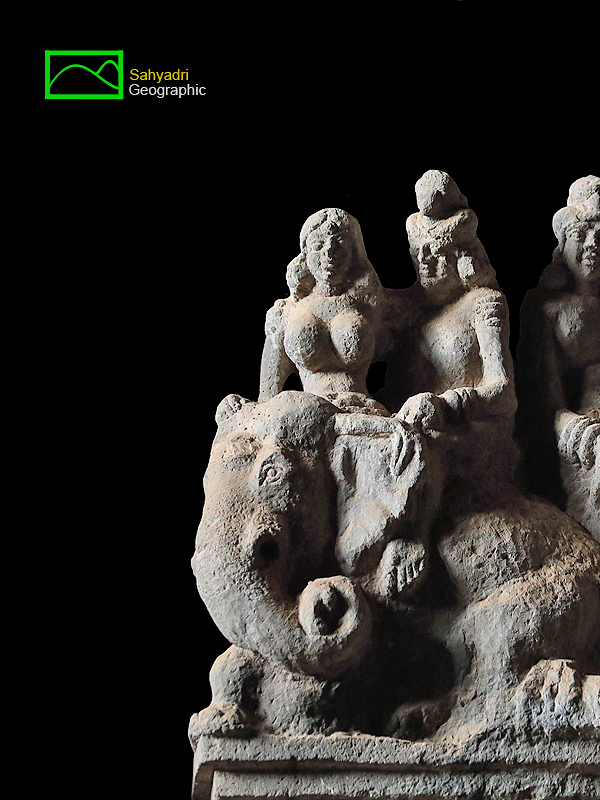 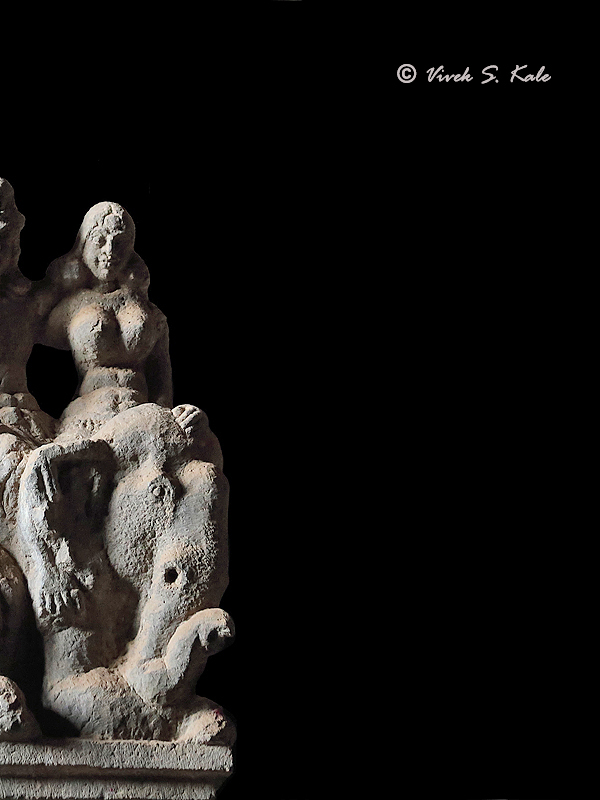 |
| |
| 30. Pillar L6, Chaityagriha, Karle Caves, Maval Tehsil, Pune district, Maharashtra, India |
| |
|
|
| |
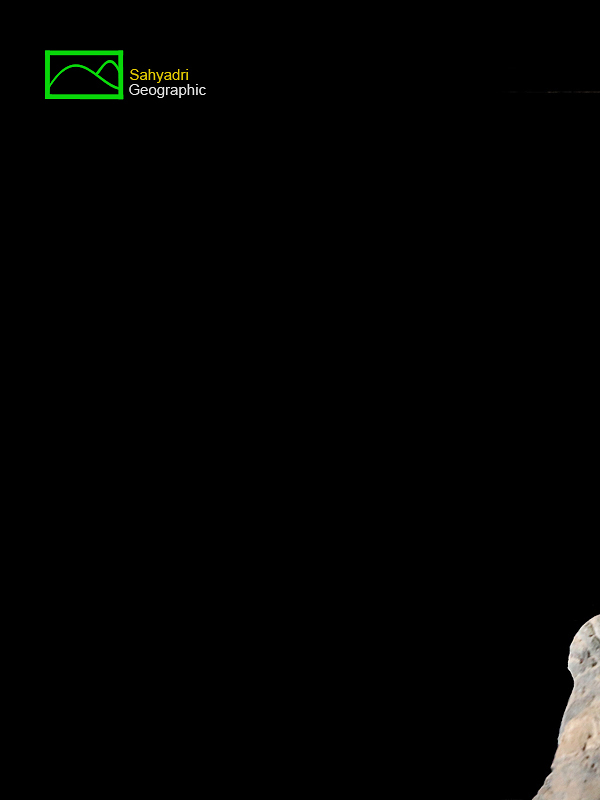  |
| |
| 31. Pillar L6, Chaityagriha, Karle Caves, Maval Tehsil, Pune district, Maharashtra, India |
| |
|
|
| |
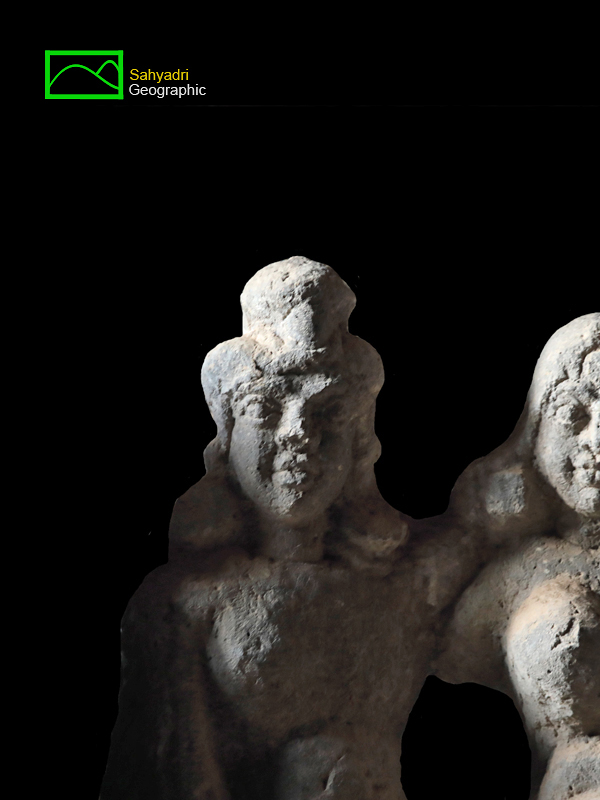 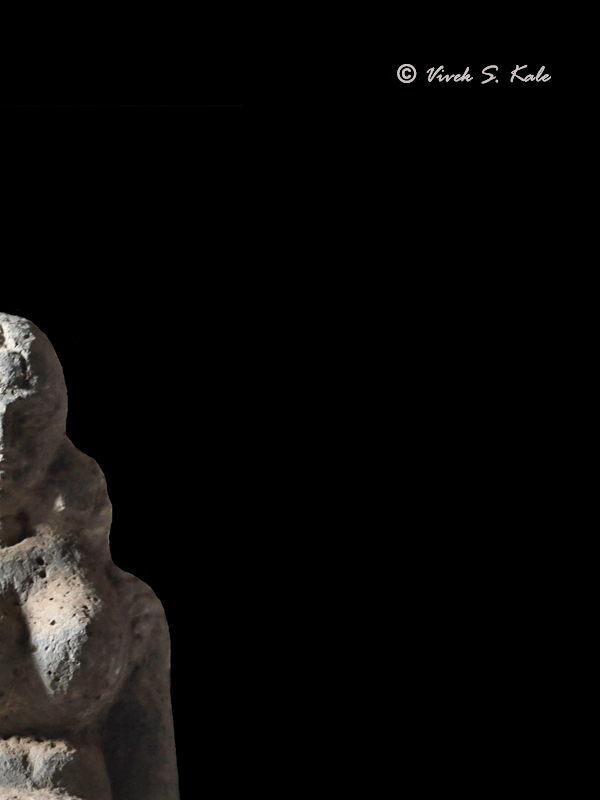 |
| |
| 32. Pillar L6, Chaityagriha, Karle Caves, Maval Tehsil, Pune district, Maharashtra, India |
| |
|
|
| |
  |
| |
| 33. Inscription at Pillar L6, Chaityagriha, Karle Caves, Maval Tehsil, Pune district, Maharashtra, India |
| |
|
|
धेनुकाकटा सोमिलनकस
दानं थम्बो
शिलालेखांचे मराठी भाषांतर
धेनुकाकट च्या सोमिलकाकडुन स्तंभाकरिता दान.
धेनुकाकटा : गावाचे नाव, सोमिलनका : देणगीदाराचे नाव, थंबो : खांब
|
|
Dhenukākatā Somilanakasa
dāna thambo
Meaning in English :
"The gift of a pillar by Somilanaka from Dhenukakata"
Dhenukakat : Name of the place, Somilanaka : Name of the donor
|
|
|
| |
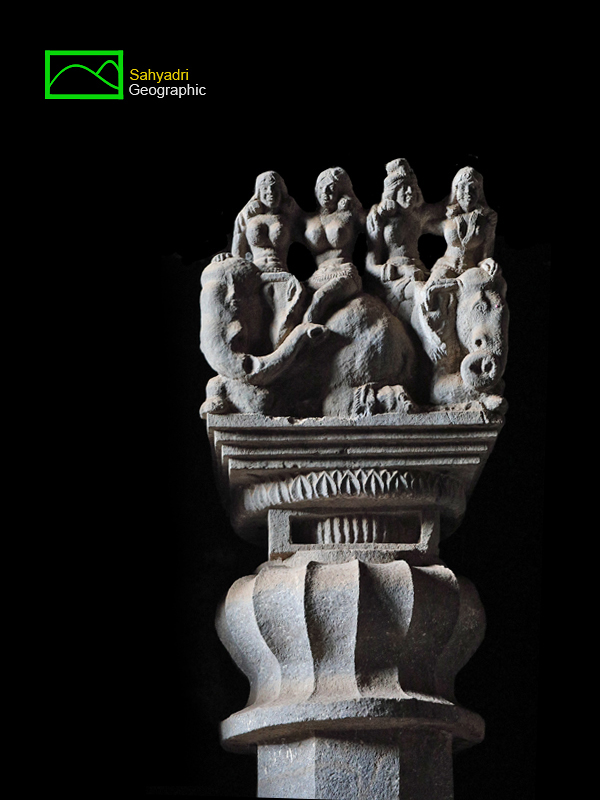 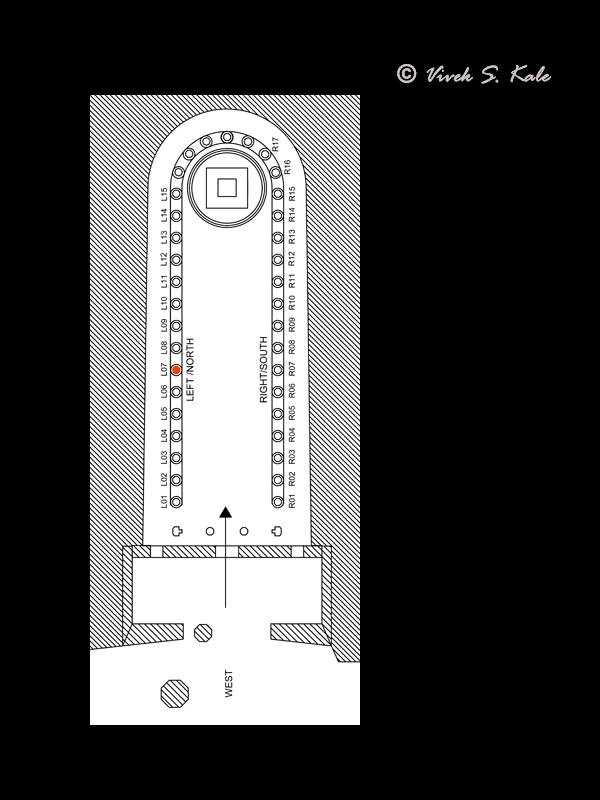 |
| |
| 34. Pillar L7, Chaityagriha, Karle Caves, Maval Tehsil, Pune district, Maharashtra, India |
| |
|
|
छायाचित्रात सातवा अष्टकोनी खांब (डाव्या रांगेतील/ उत्तरेकडील) दाखविलेला आहे. यात खांबावरची पुढच्या बाजुची शिल्पे दाखविलेली आहेत. या शिल्पात दोन हत्ती आहेत. दोन्ही हत्तींवर स्त्री-पुरुष जोड़्या आरुढ झालेल्या आहेत.
स्त्री शिल्पात गळ्यातला हार, बांगड़्या आणि कपाळावरचे आभूषण (टिका) ही आभुषणे आहेत. पुरुष शिल्पाच्या हातात कडे आहेत. स्त्री आणि पुरुष पारंपारिक परिवेषात आहेत.
या खांबाच्या मागच्या बाजूस स्त्री-पुरुष जोड़्या बैल आणि घोड़्यावर आरुढ झालेले पहावयास मिळतात.
या खांबावर एक शिलालेख आहे. हा शिलालेख पाली भाषेत ब्राह्मी लिपीत कोरलेला आहे. शिलालेखांचे मराठी भाषांतर "धेनुकाकट चा उसभदत चा पुत्र मितदेवनका कडुन स्तंभाकरिता दान." असे आहे.
|
|
Seventh octagonal pillar, (with sculptures on its capital) on left hand side (person facing stupa) i.e. on north side in Karla Chaityagriha is shown in the image. In this image, only the sculptures facing the main hall are highlighted and the image does not show the other details such as top of the pillar, backside of the pillar and wall behind. On one of the elephants a human pair of male and female is riding. On the other elephant other human pair of female riders can be seen. Interesting ornaments such as waist jewelry, wrist bracelets and forehead jewelry can be seen here on the female riders. The wrist bracelet can be seen on the male rider. This pillar has male and female human riders riding on bull and horse on the alley side (back side). This pillar has Prakrit inscription in Brahmi script. The meaning of the inscription is, "The gift of a pillar by Mitadevanaka son of Usabhadata from Dhenukakata"
|
|
|
| |
 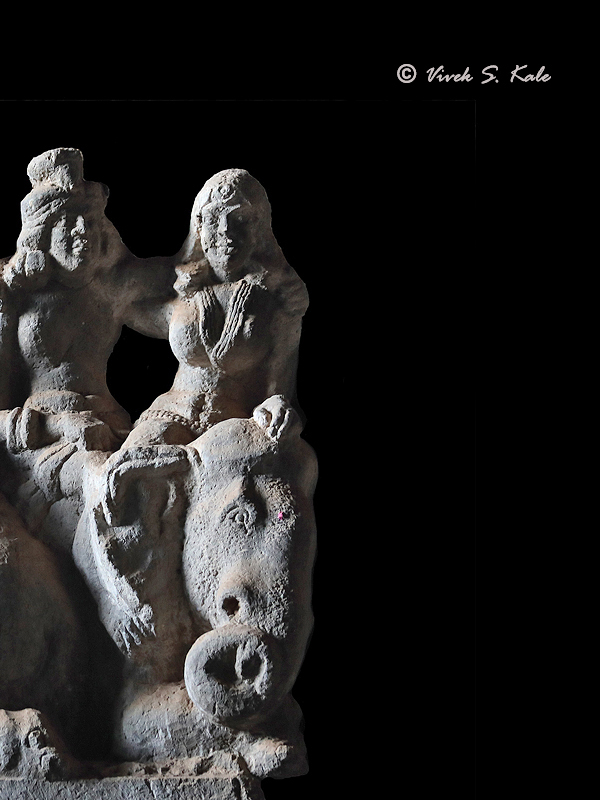 |
| |
| 35. Pillar L7, Chaityagriha,Karle Caves, Maval Tehsil, Pune district, Maharashtra, India |
| |
|
|
| |
  |
| |
| 36. Pillar L7, Chaityagriha,Karle Caves, Maval Tehsil, Pune district, Maharashtra, India |
| |
|
|
| |
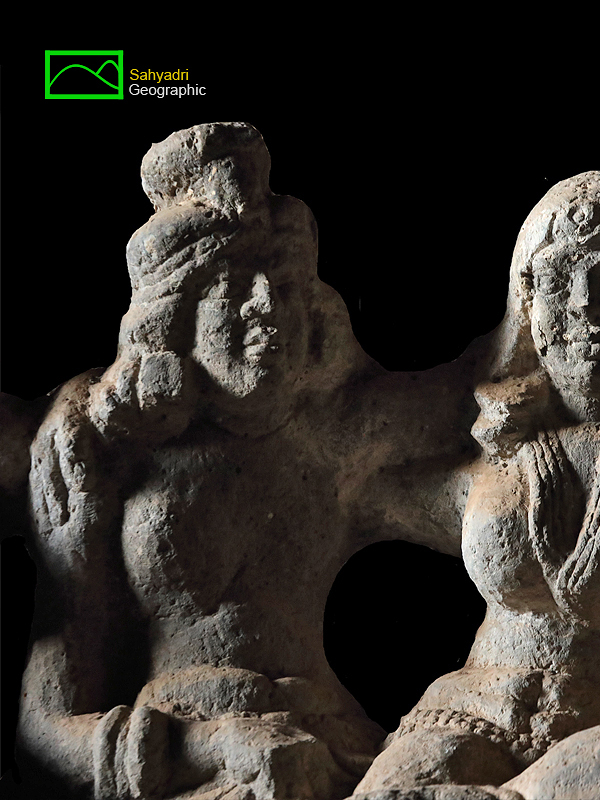 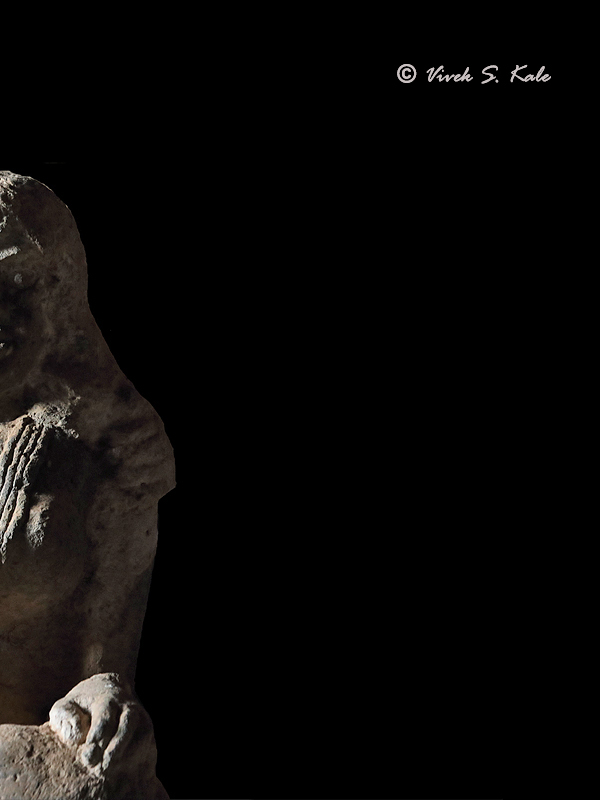 |
| |
| 37. Pillar L7, Chaityagriha,Karle Caves, Maval Tehsil, Pune district, Maharashtra, India |
| |
|
|
| |
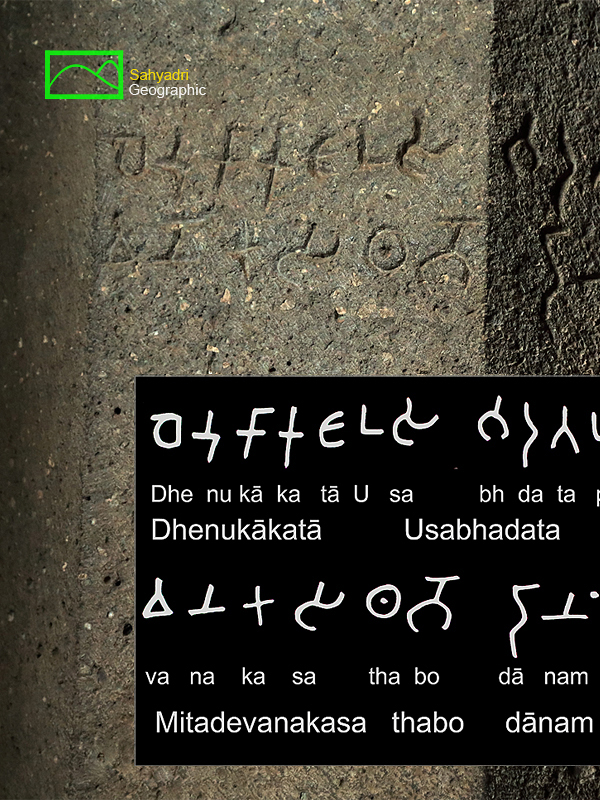  |
| |
| 38. Inscription at Pillar L7, Chaityagriha,Karle Caves, Maval Tehsil, Pune district, Maharashtra, India |
| |
|
|
धेनुकाकटा उसभदत पुतस मितदेवनकस थम्बो दानं
शिलालेखांचे मराठी भाषांतर
धेनुकाकट चा उसभदत चा पुत्र मितदेवनका कडुन स्तंभाकरिता दान.
धेनुकाकटा : गावाचे नाव, मितलनका : देणगीदाराचे नाव, थंबो : खांब, उसभदत : शक राजा नाहापान चा जावई
|
|
Dhenukākatā Usabhadata putasa Mitadevanakasa thabo dānam
Meaning in English :
"The gift of a pillar by Mitadevanaka son of Usabhadata from Dhenukakata"
Ref : Inscriptions from the cave temples of western India, J. Burgess and Bhagwanlal I. Pandit, 1881
"(This) pillar (is) the gift of Mahadevanaka, son of Usabhadata, from Dhenukakata"
Remarks : Senart felt that Mitradevais son of Rishabhdata who is mentioned in other inscriptions as son in law of Nahapana.
Ref : "The inscriptions at caves of Karla by E. Senart",Epigraphia India,Volume VII
Dhenukakat : Name of the place, Mitadevanaka : Name of the donor, Thabo : Pillar, danam : Donation, Usabhadata : Name of the person
|
|
|
| |
  |
| |
| |
| |
|
|
| |
 |
| |
|
|
References :
1. “Archeological Survey of India website”, asi.nic.in, 2017
2. “Inscriptions from the cave temples of western India”, J. Burgess and Bhagwanlal I. Pandit, 1881
3. "The inscriptions at caves of Karla by E. Senart", Epigraphia Indica ,Volume VII
4. “Buddhist architecture of western India”, S. Nagaraju, 1981, Agam Kala Prakashan, New Delhi
5. “Illustrations of the rock-cut temples of India”, James Fergusson,1845
6. “Cave temples of India”, James Fergusson,James Burgess, 1880
7. “ History and Inscriptions of the Satvahanas and the western kshatrapas”, Dr V.V. Mirashi, MSBLC, 1981.
8. “The art of ancient India” Huntington, Susan L, Weatherhill, 1993
9. “ The Origin and Development of Stupa Architecture in India”, Pant Sushila, 1st ed. , 1976.
10. “Maharashtratil kahi Tamrapat and shilalekh”, V.B. kolte, MSBBC, 1987.
11. “Purabhilekhavidya”, Shobhana Gokhale,
12. “Maharashtravachya itihasache sakshidaar shilalekh ani tamprapat”, Kalpana Rayarikar, Manjiri Bhalerao, 2009
13. “Mithuna, the male and female symbol in Indian art and thought” – B K Agarwal, 1983
14. “Antiquities of India”, published by T Daniell, London, 1803
15. “Gazetter of Bombay presidency, District Poona-Governement of India, Poona 1885
|
| |
|
|
| |
|

















































































